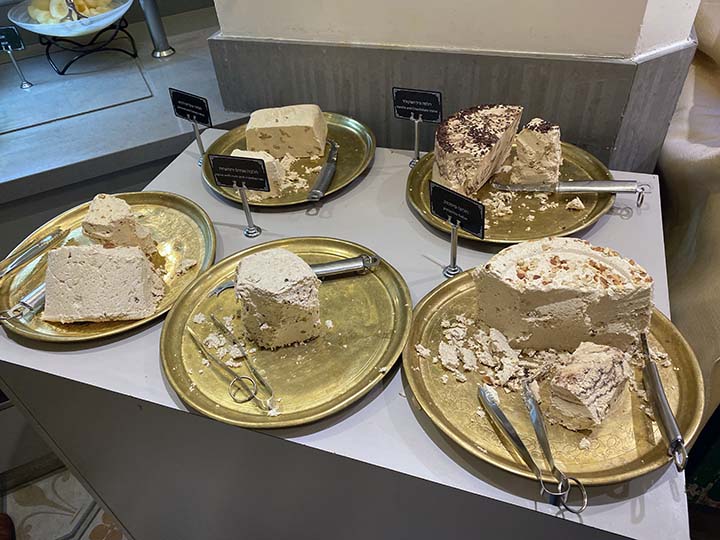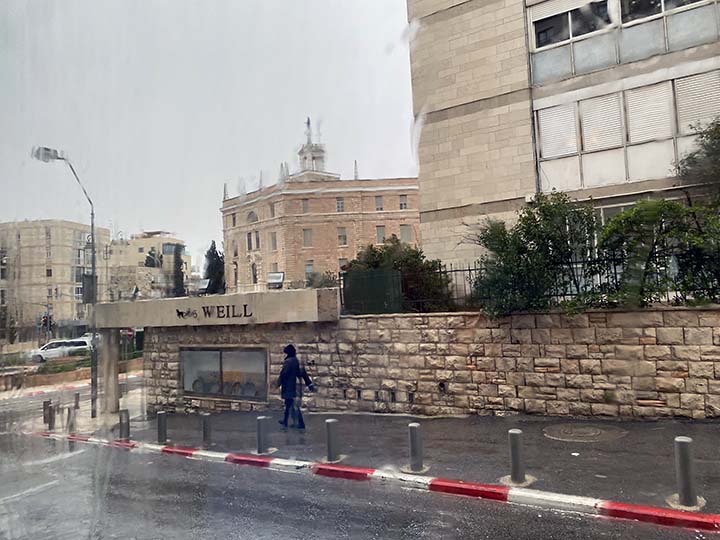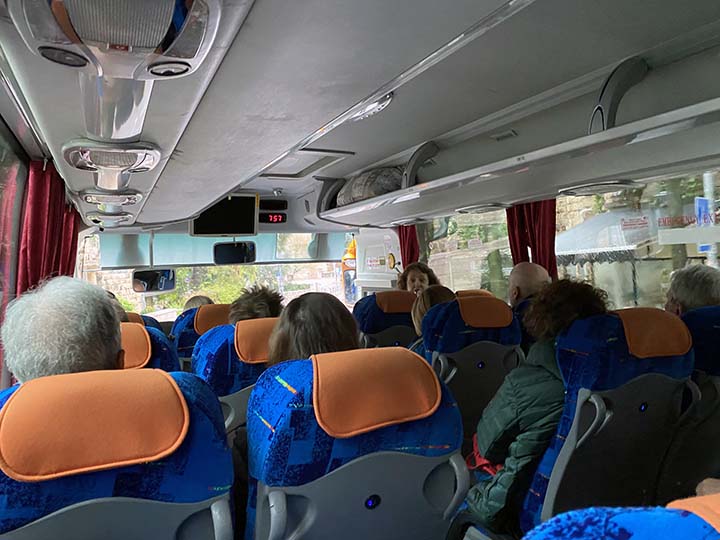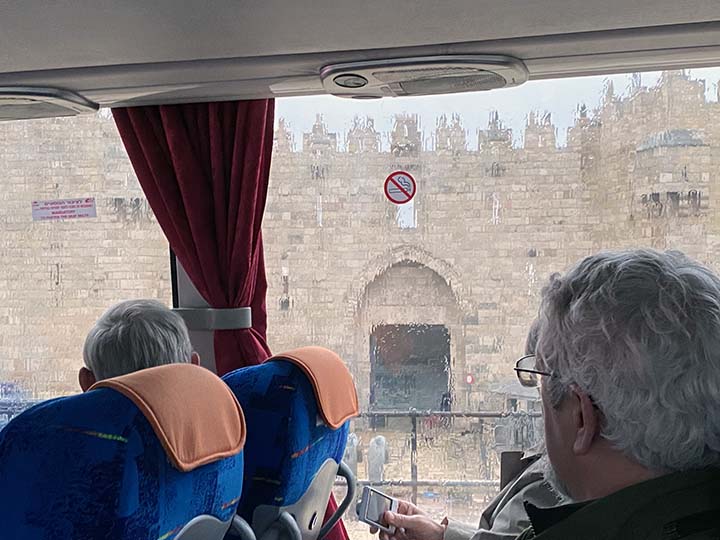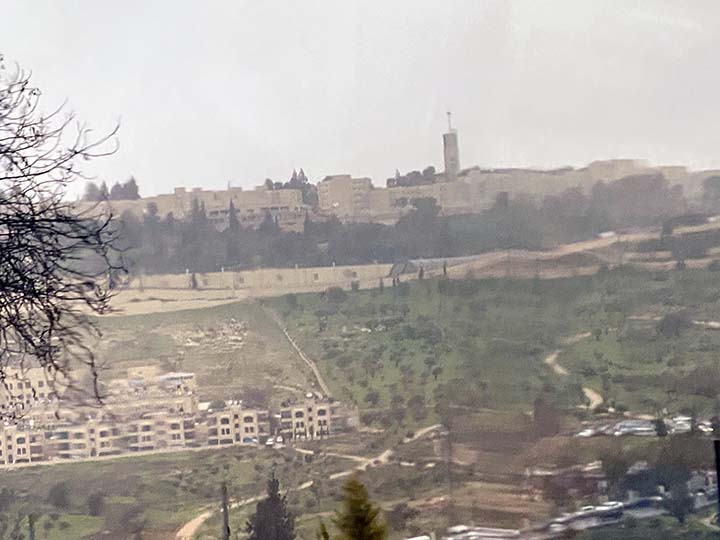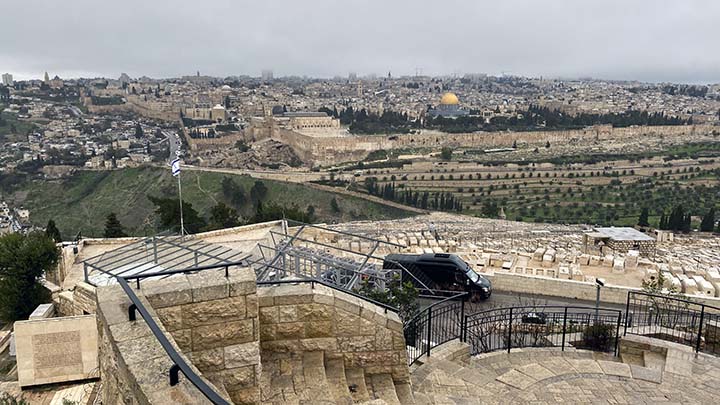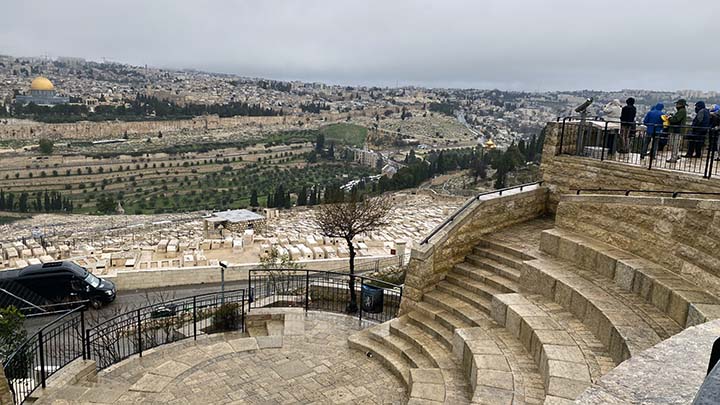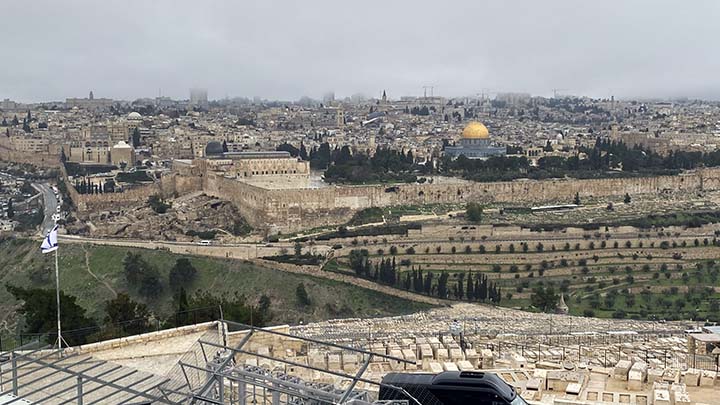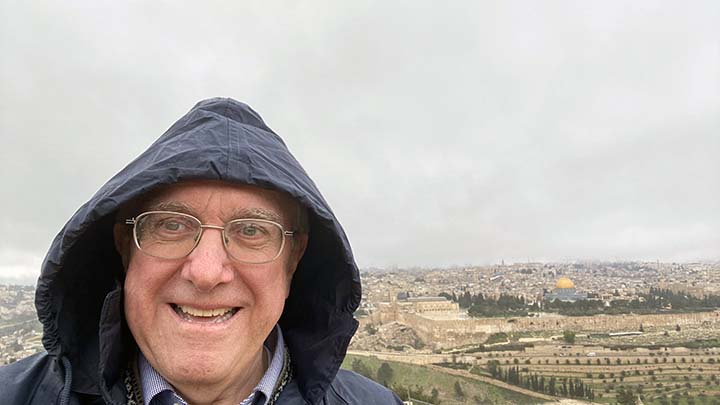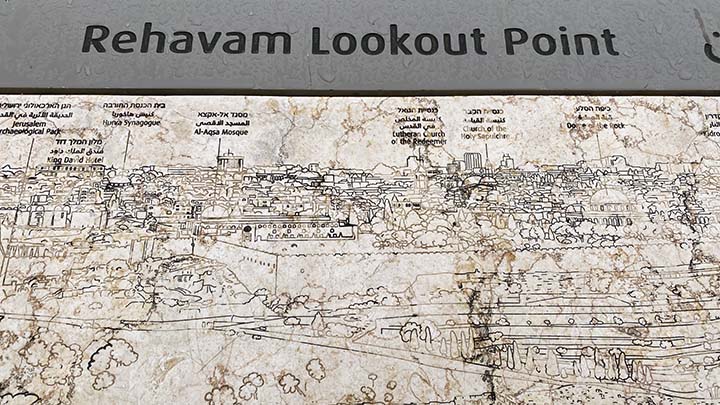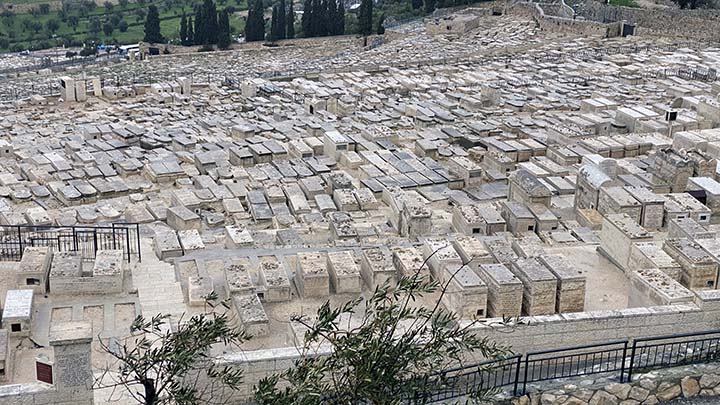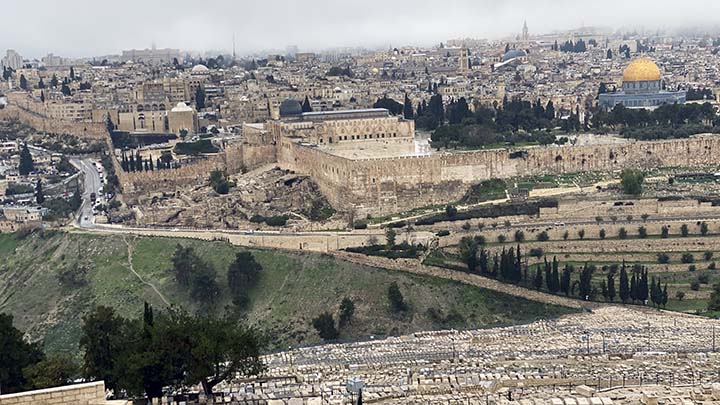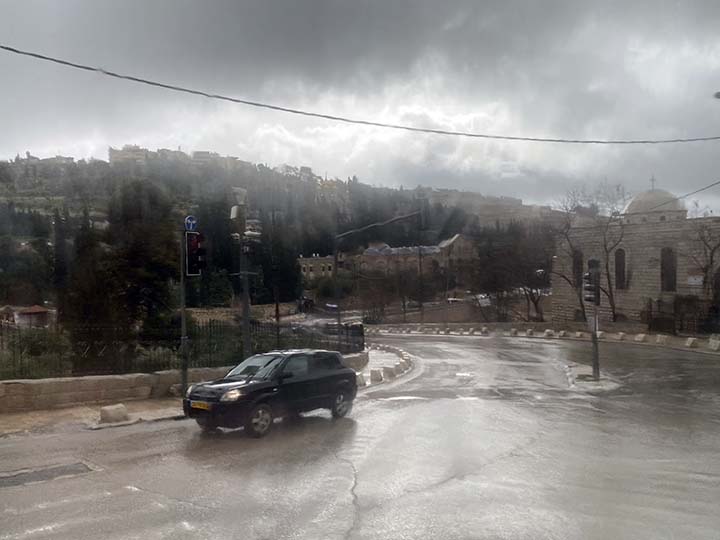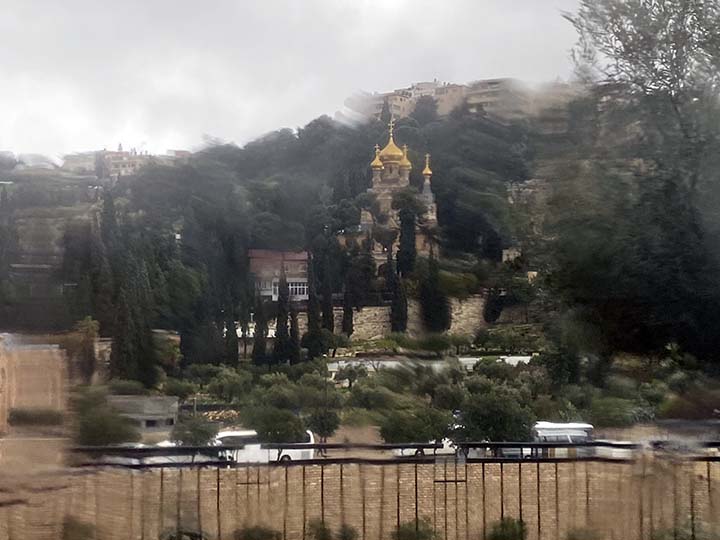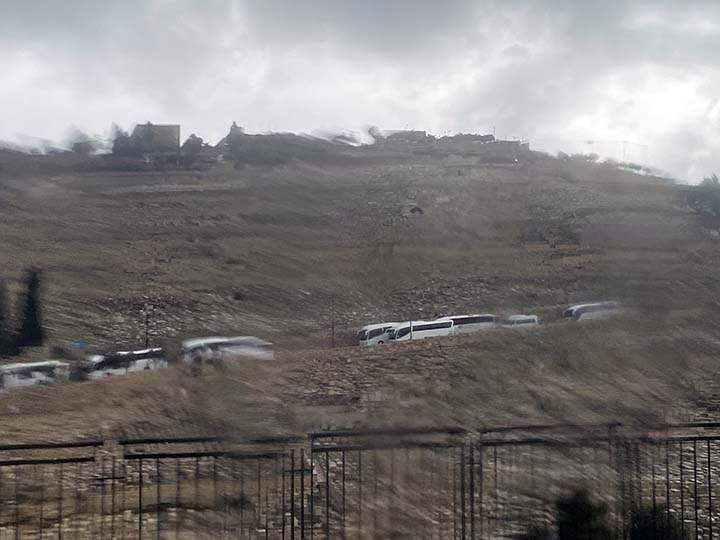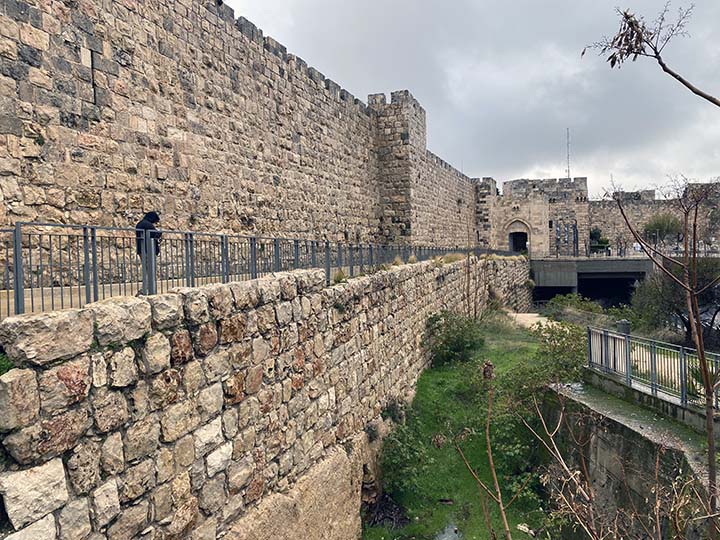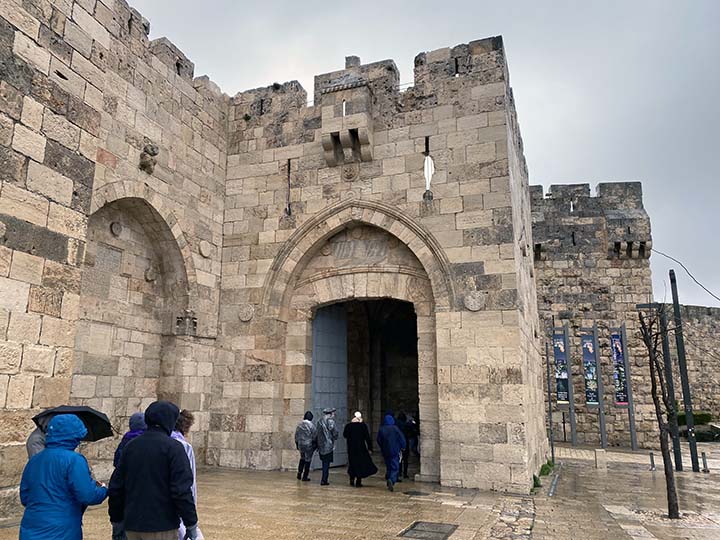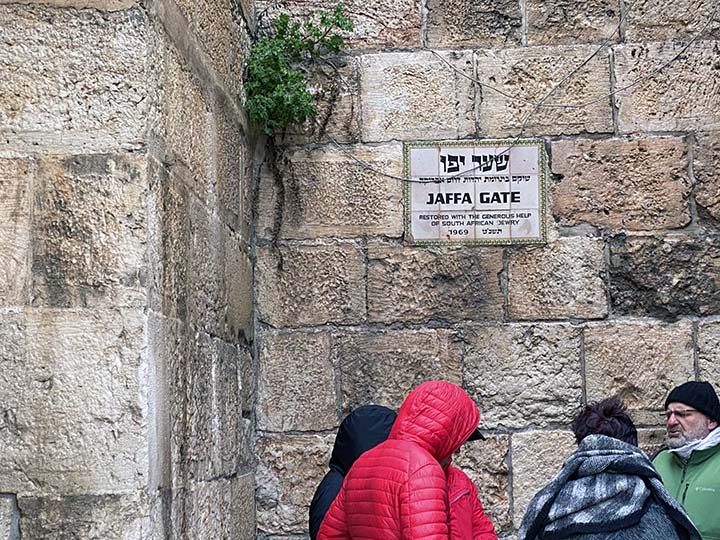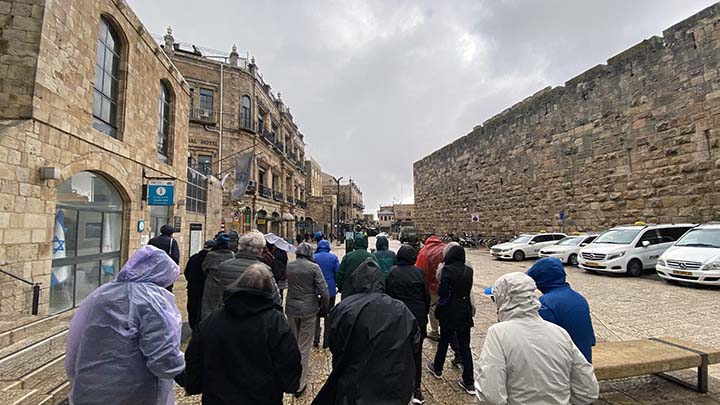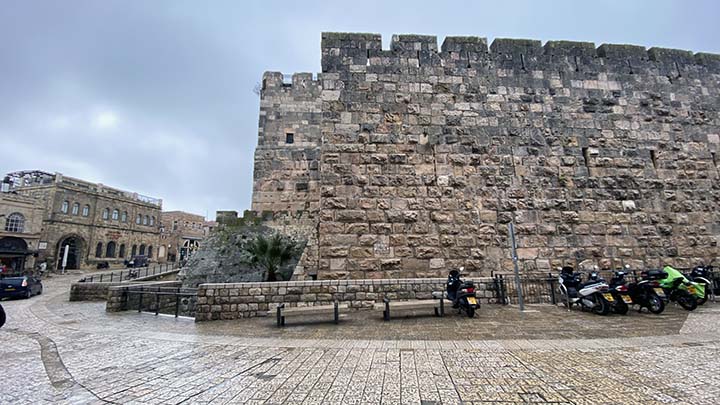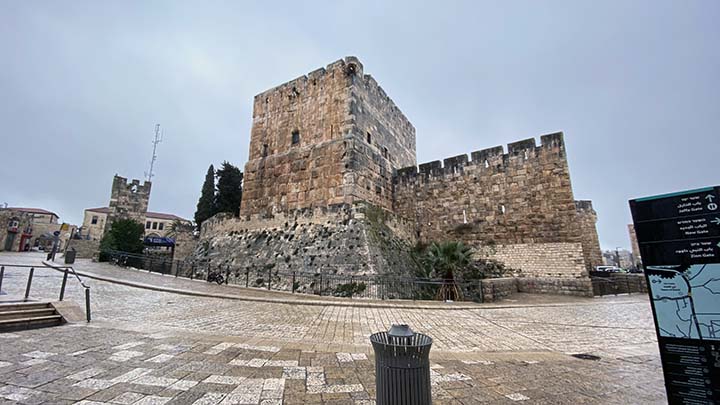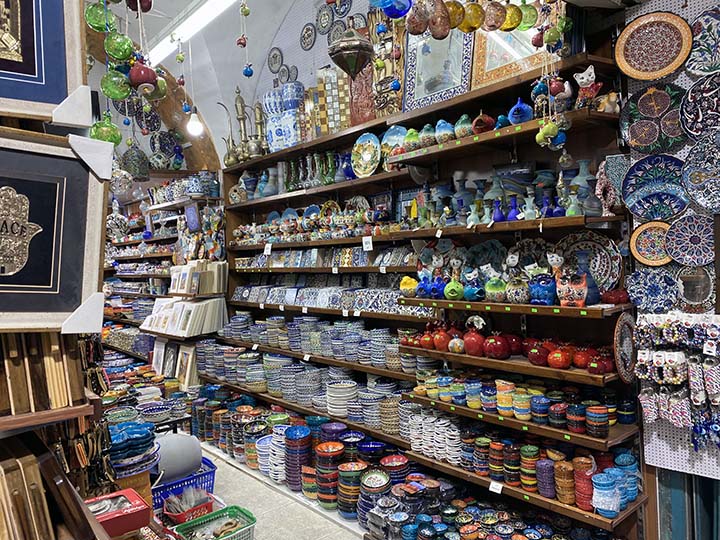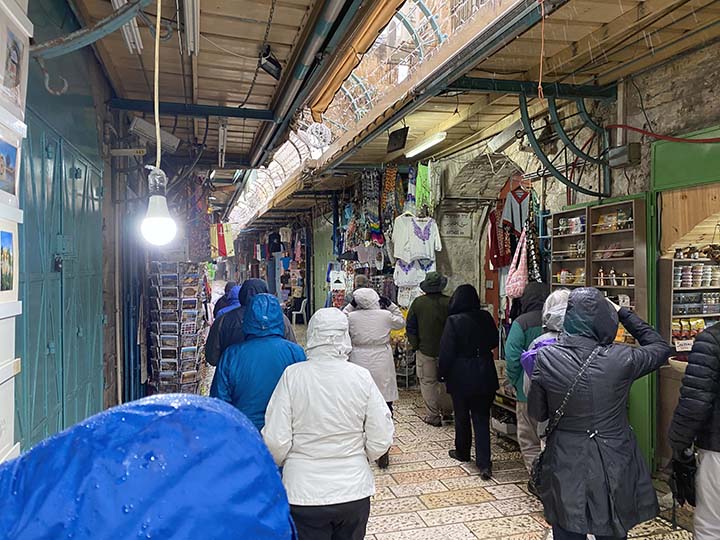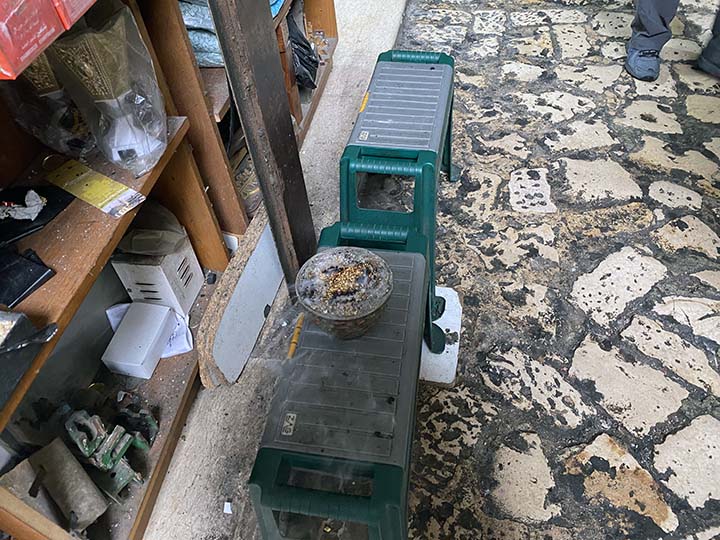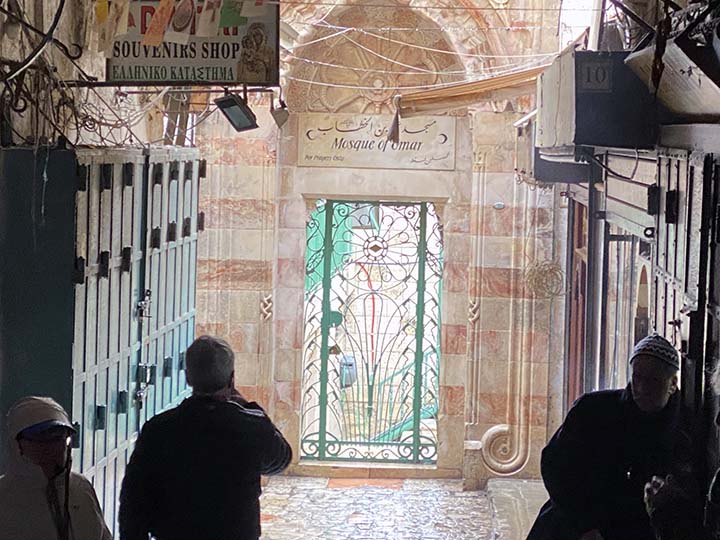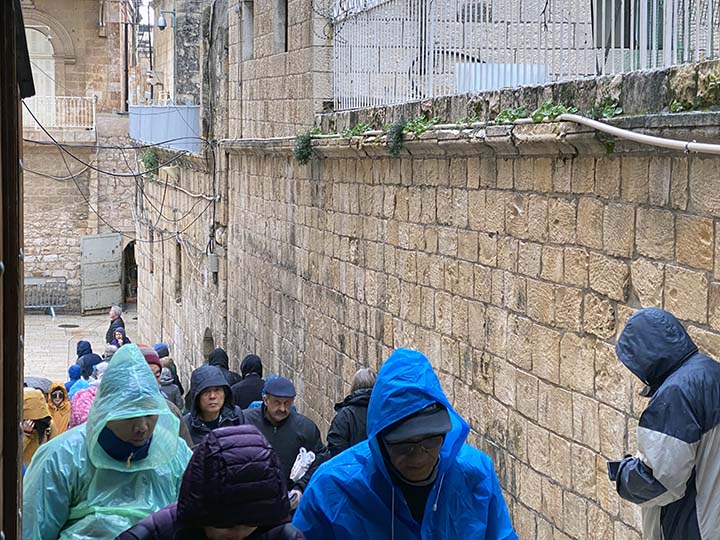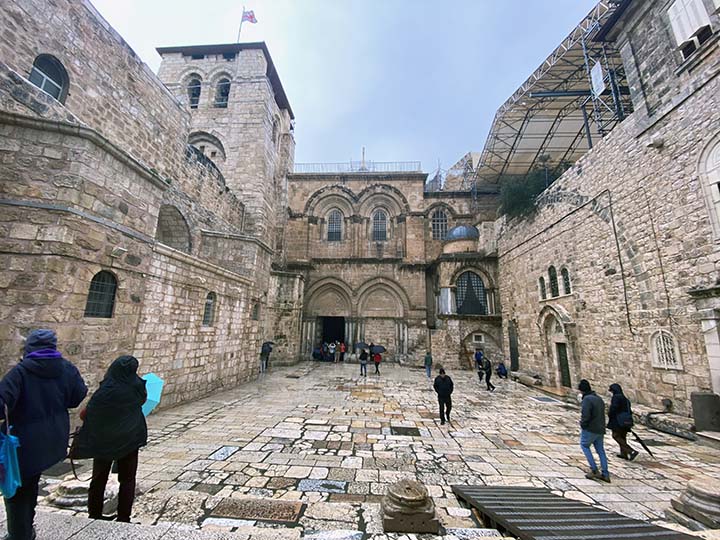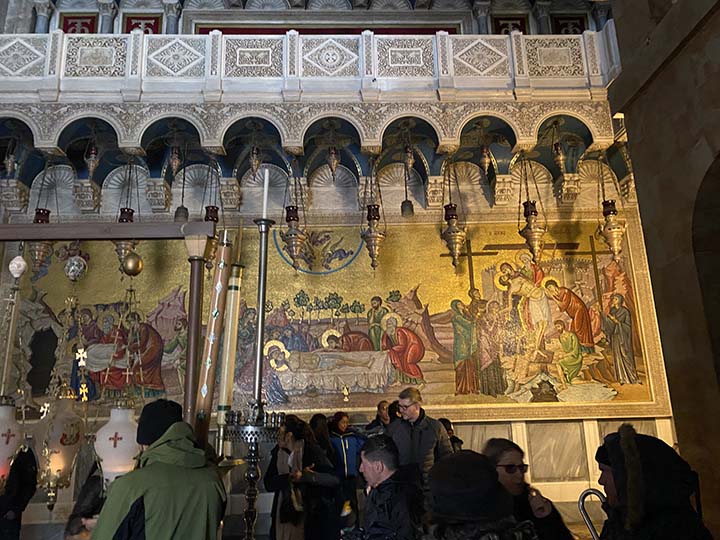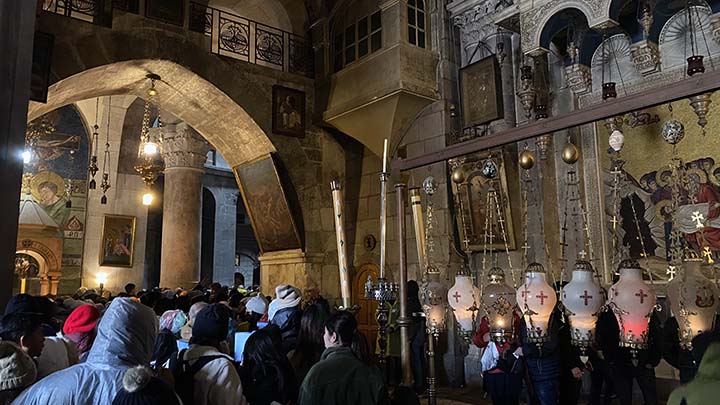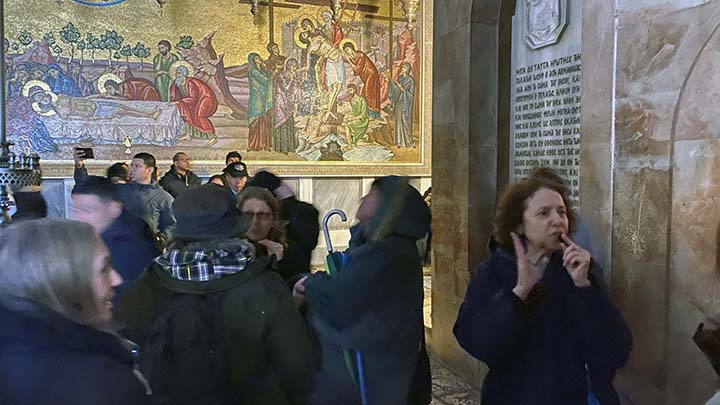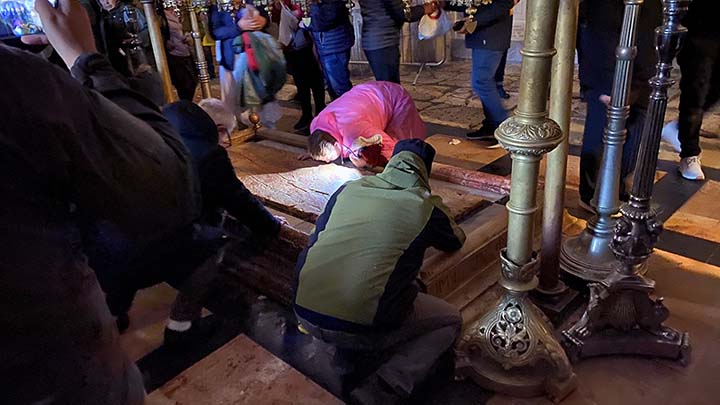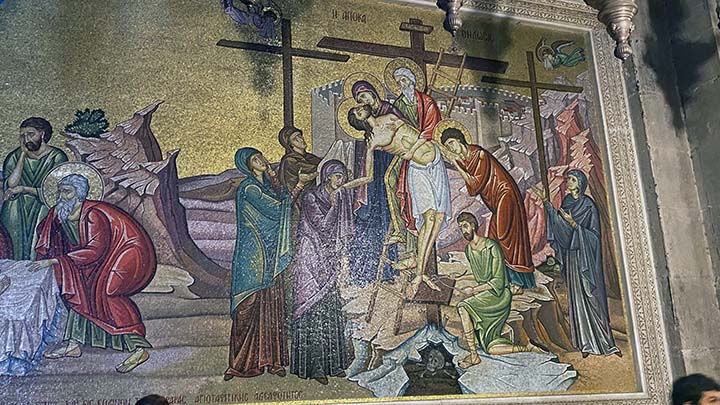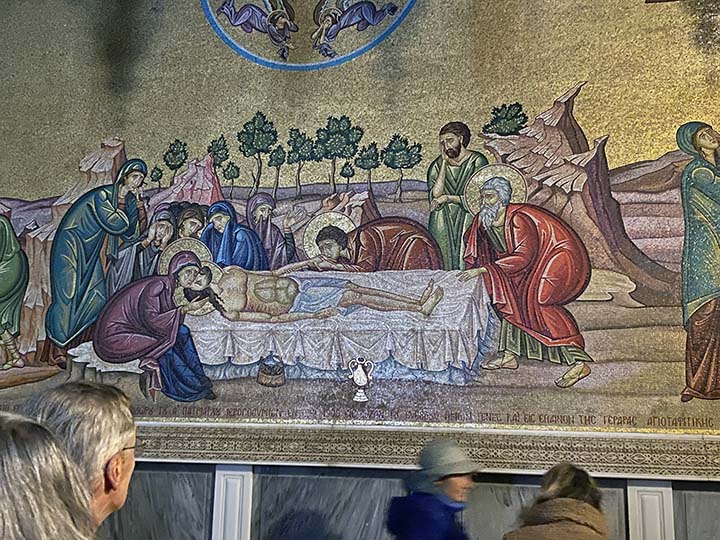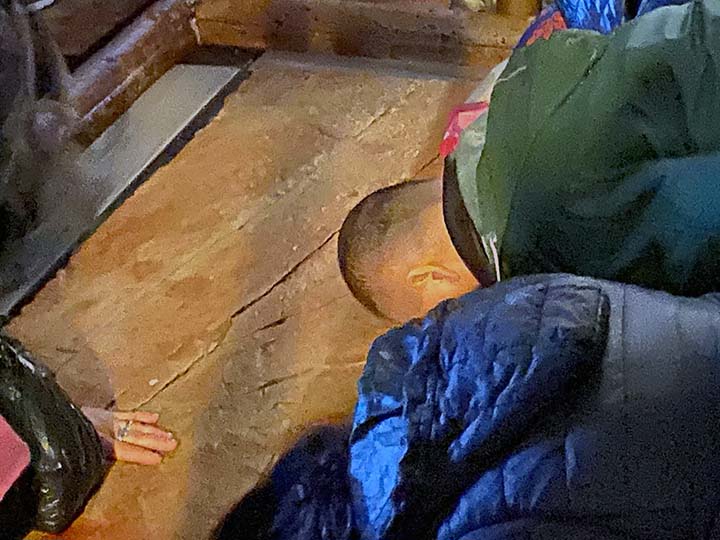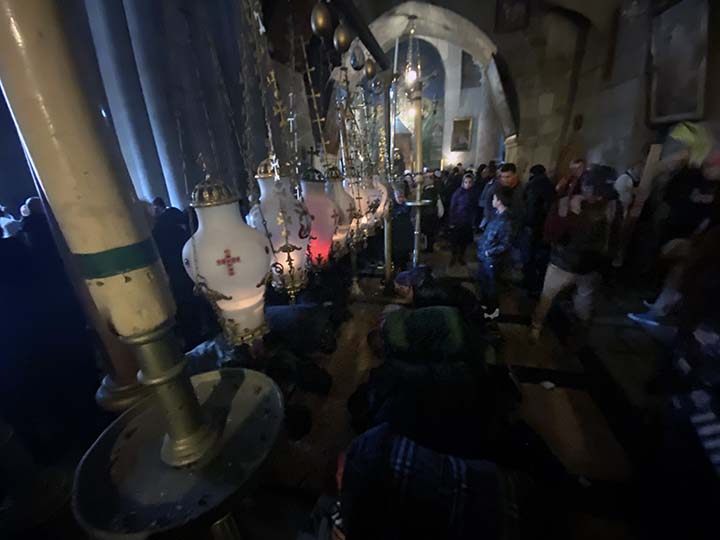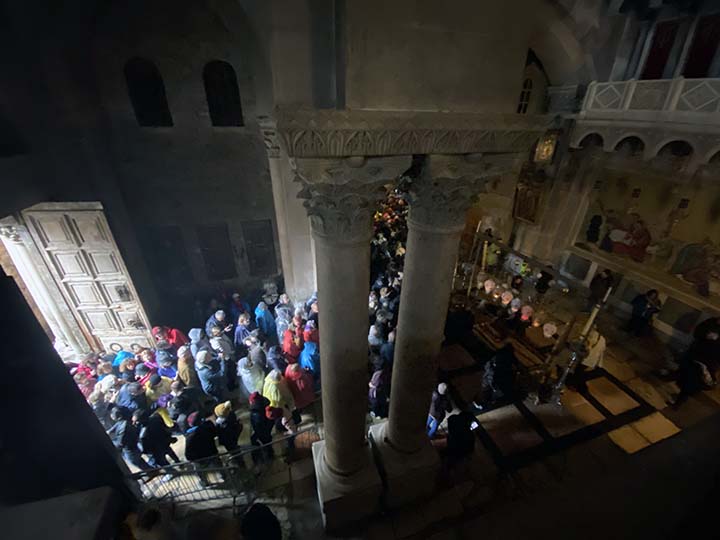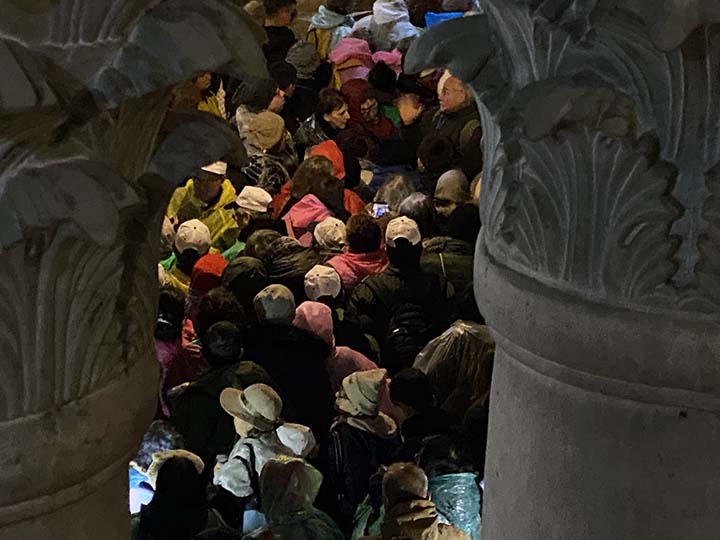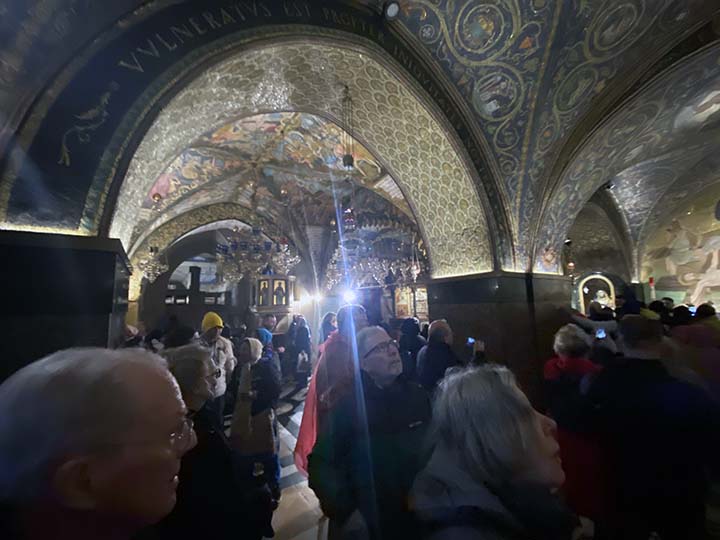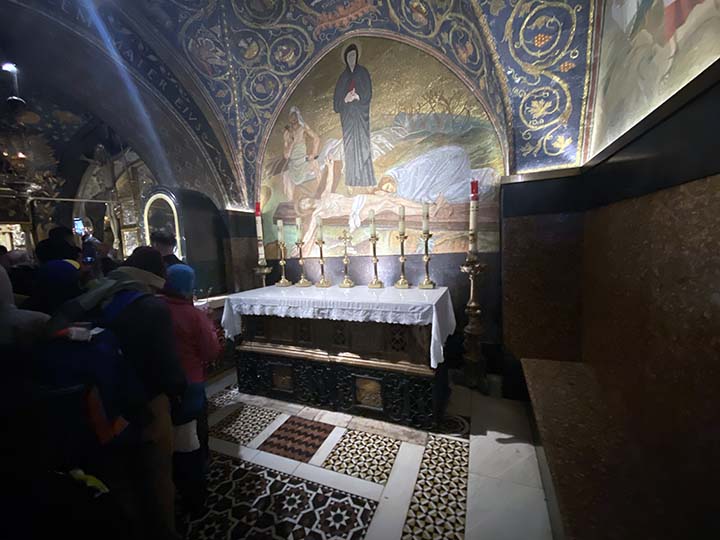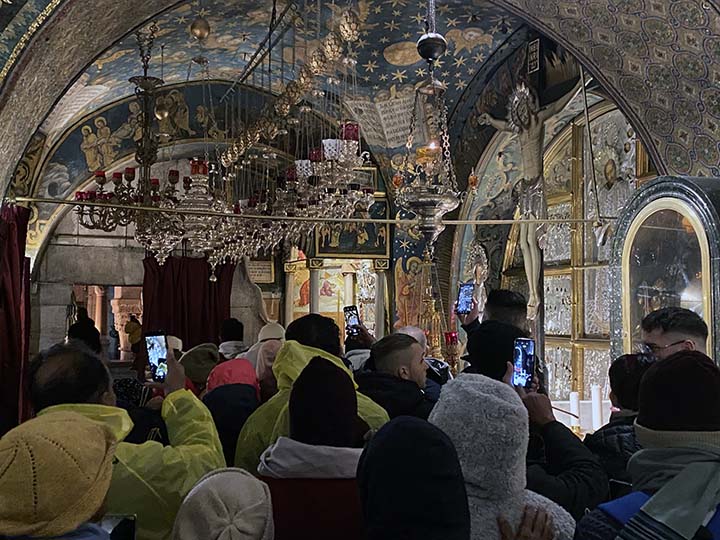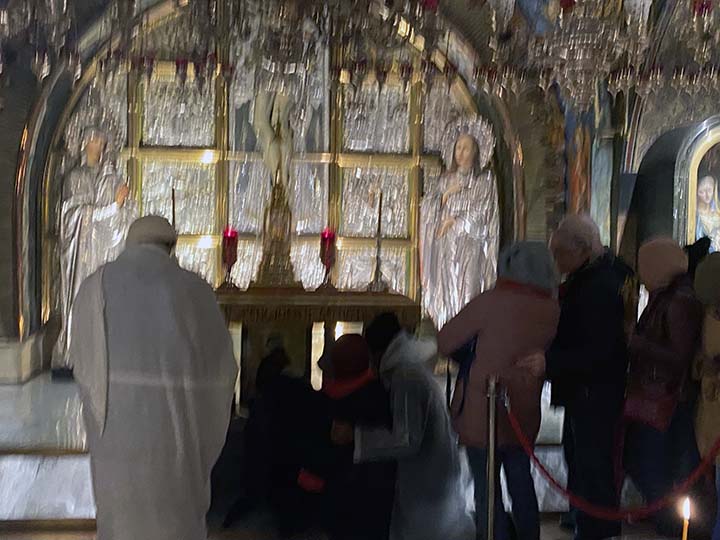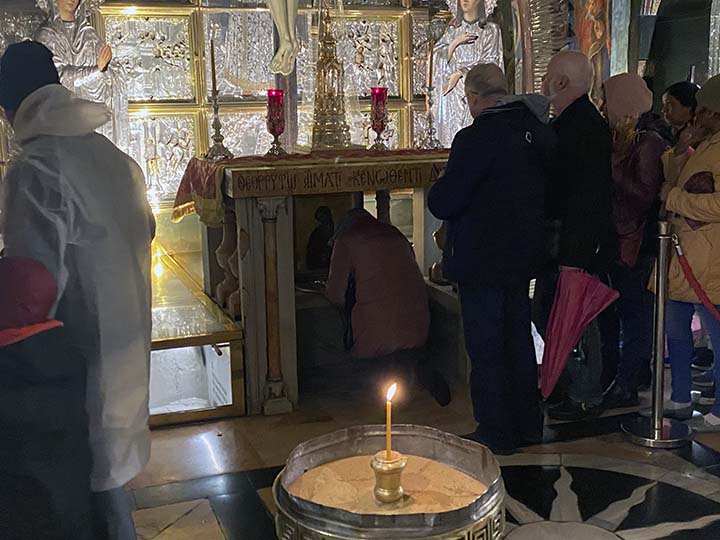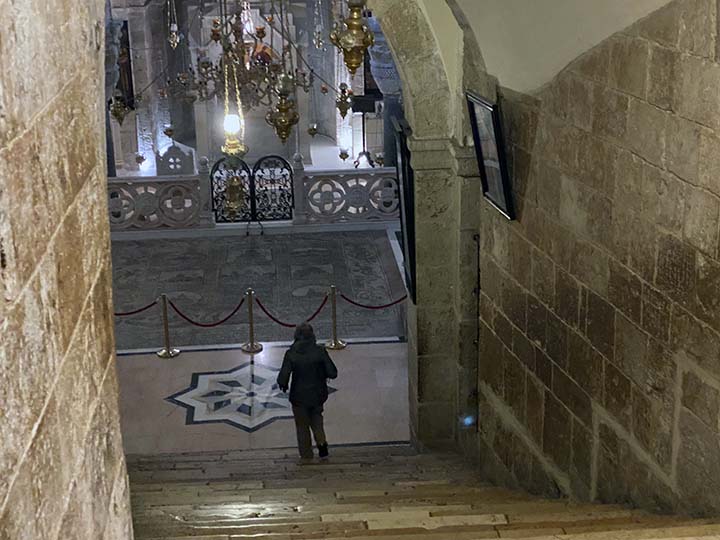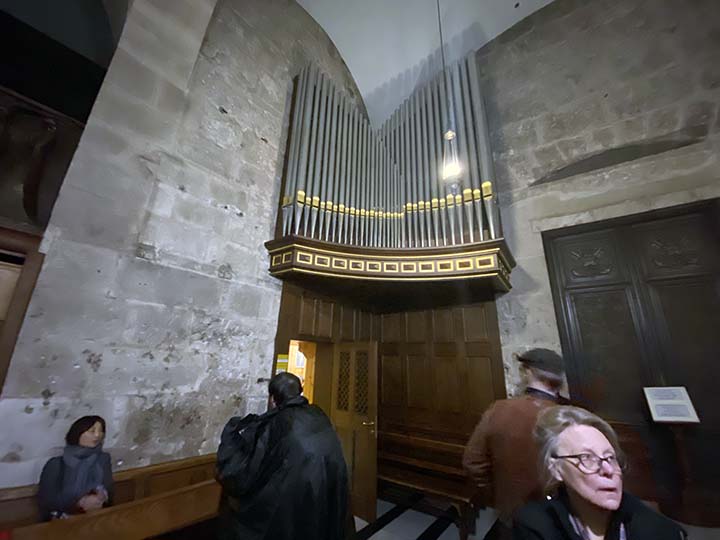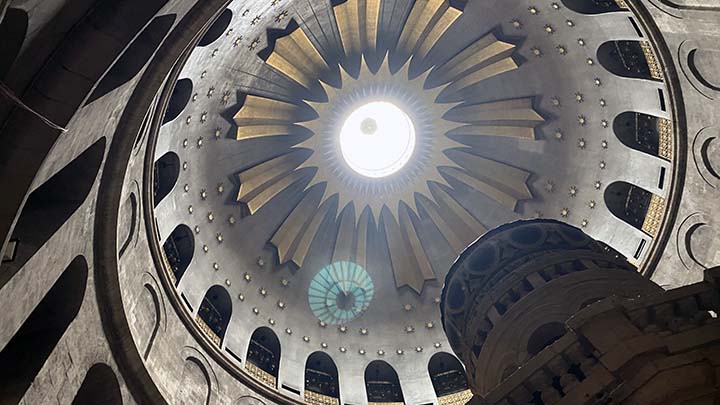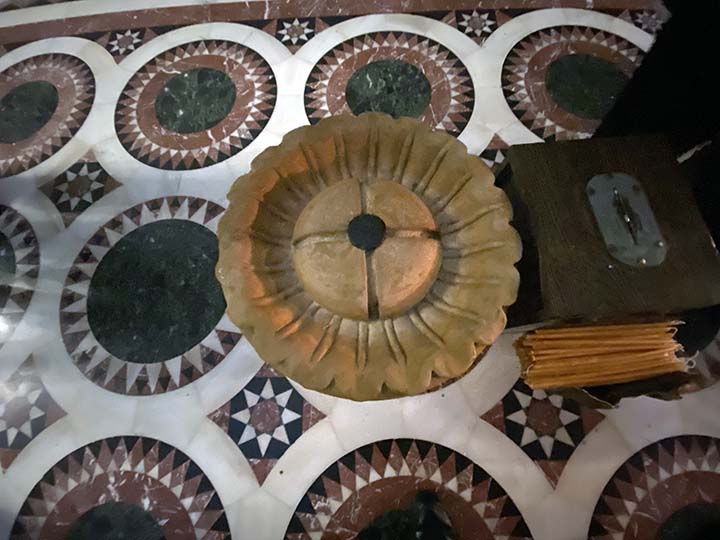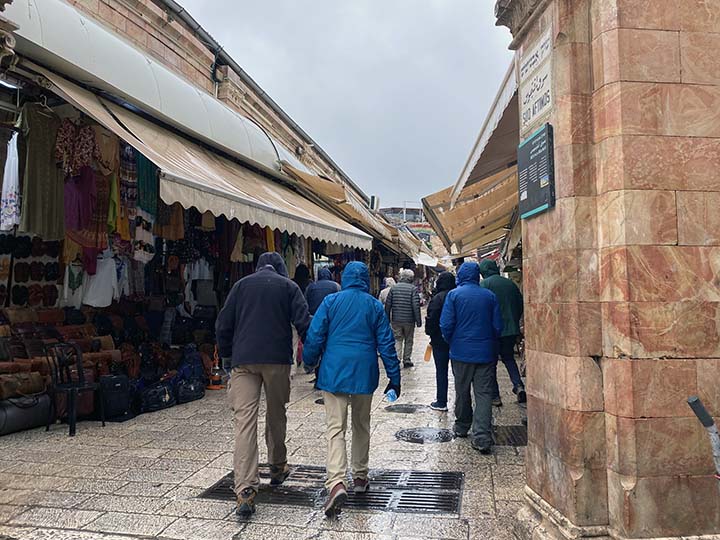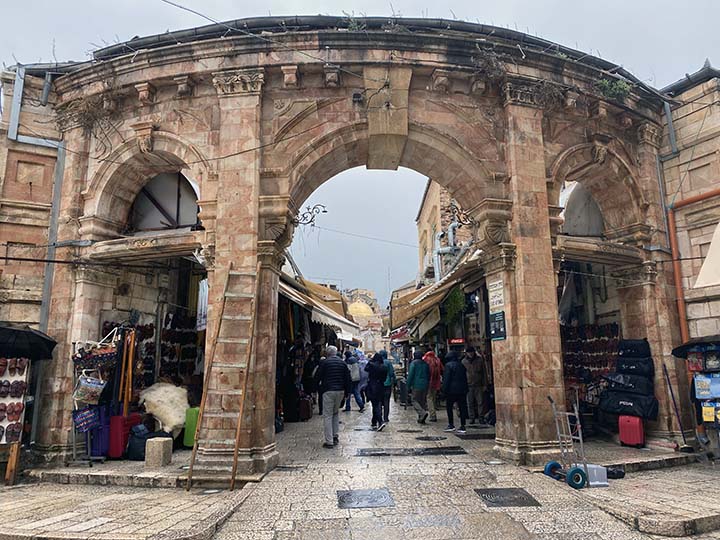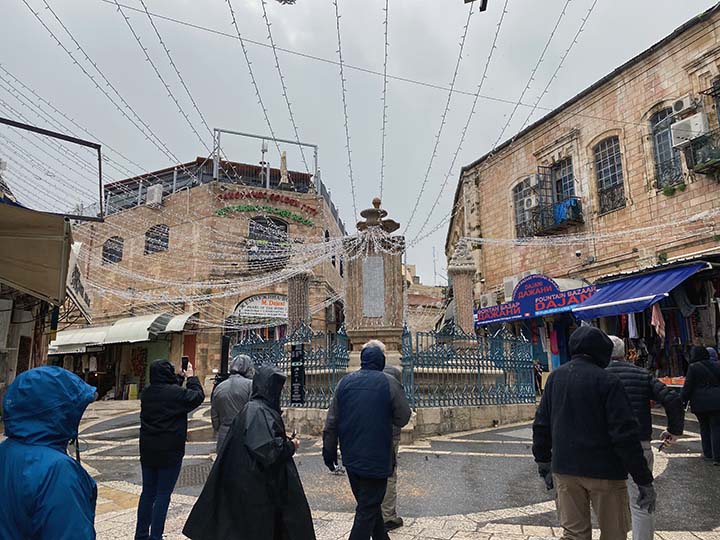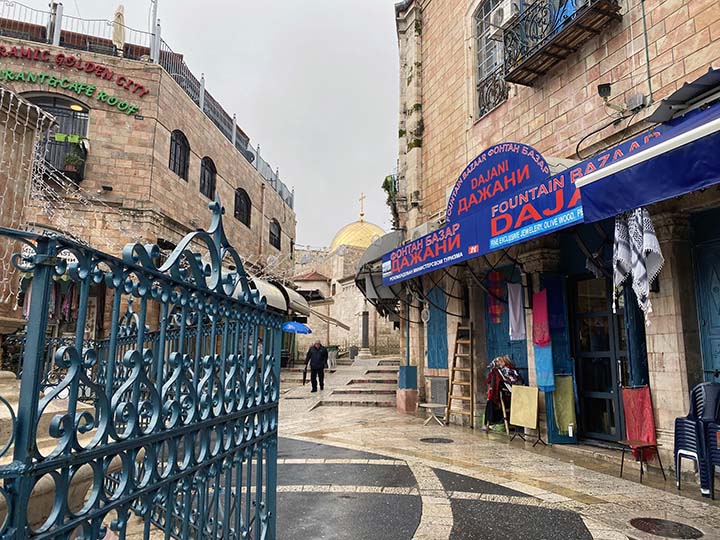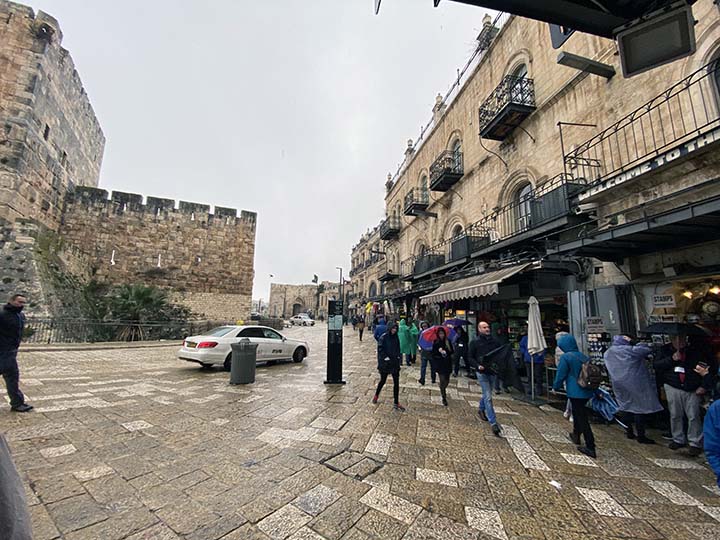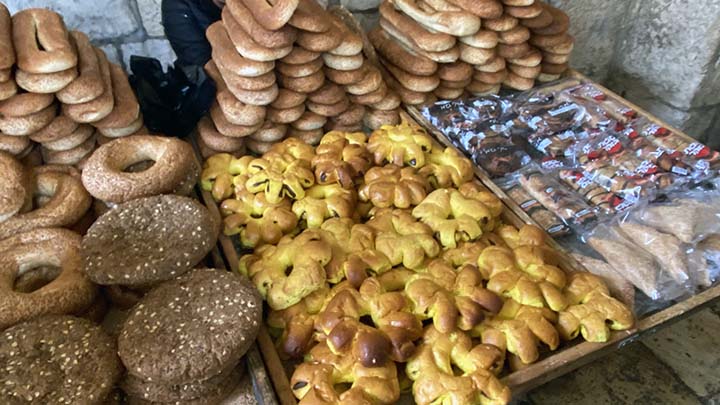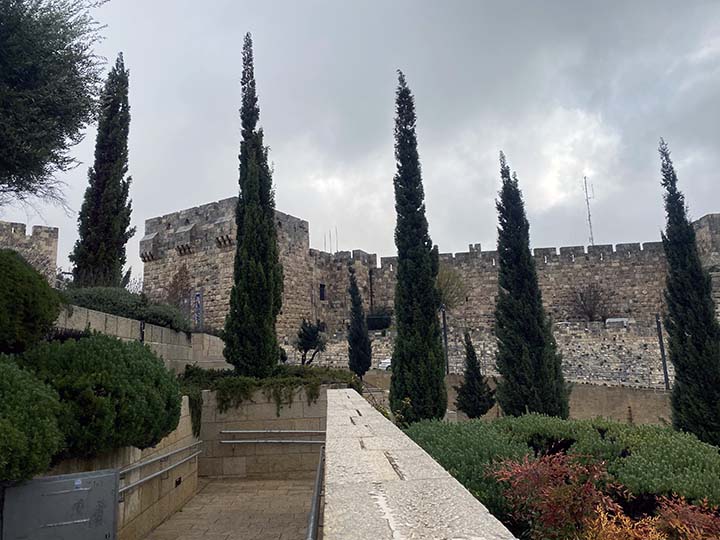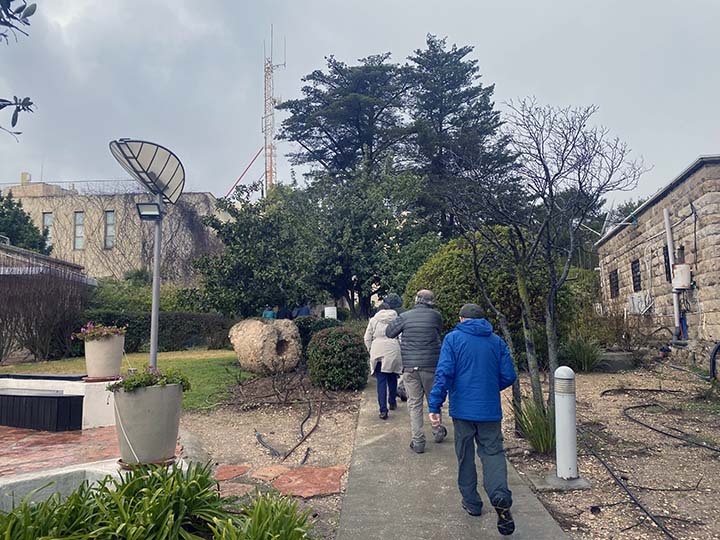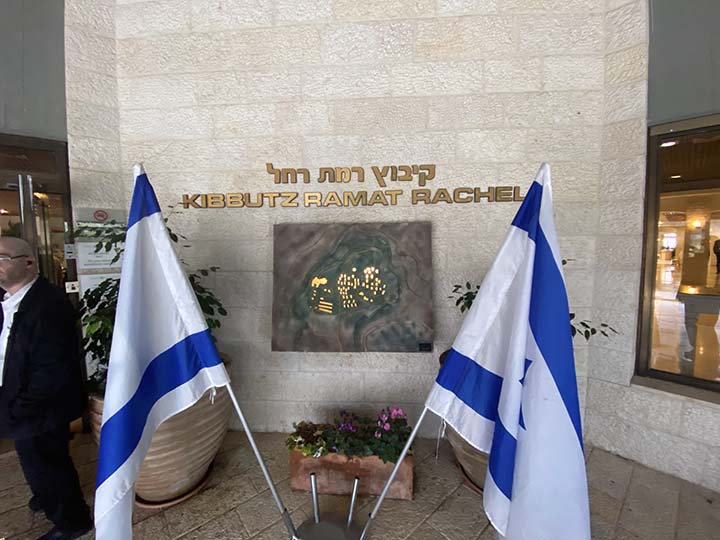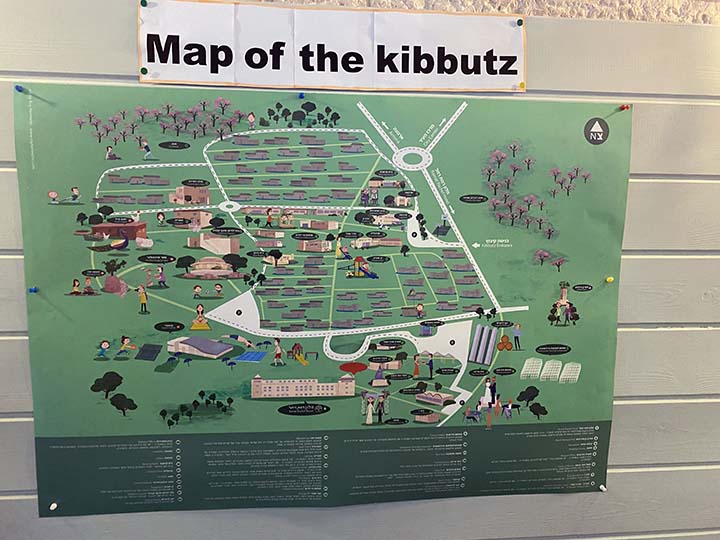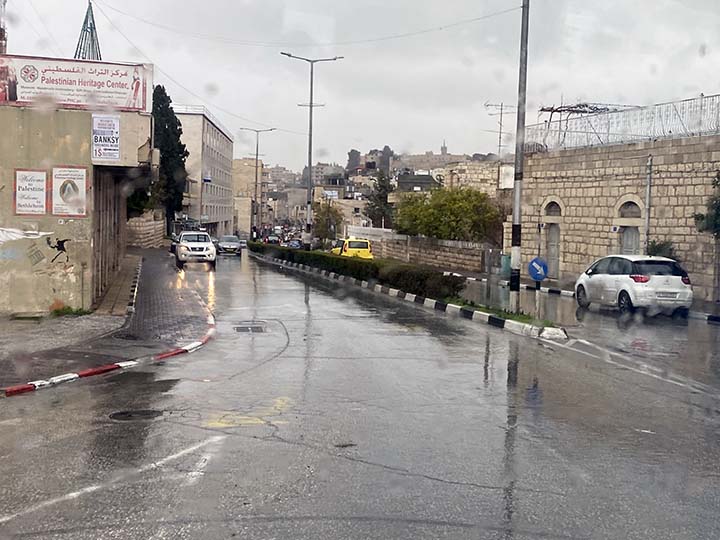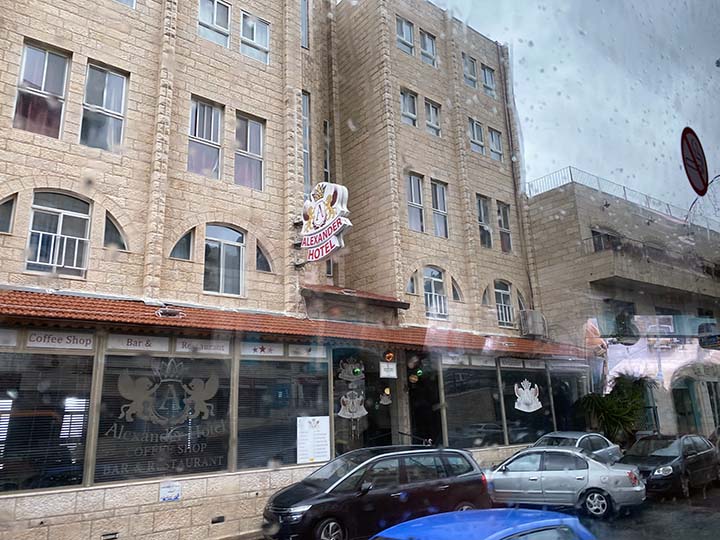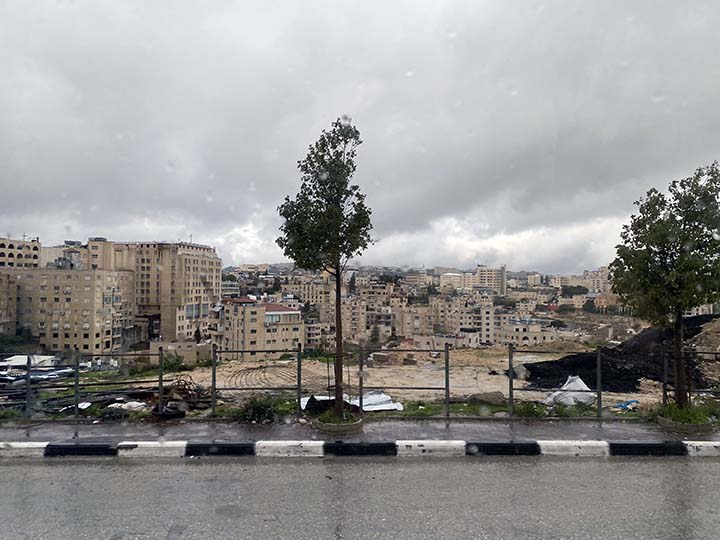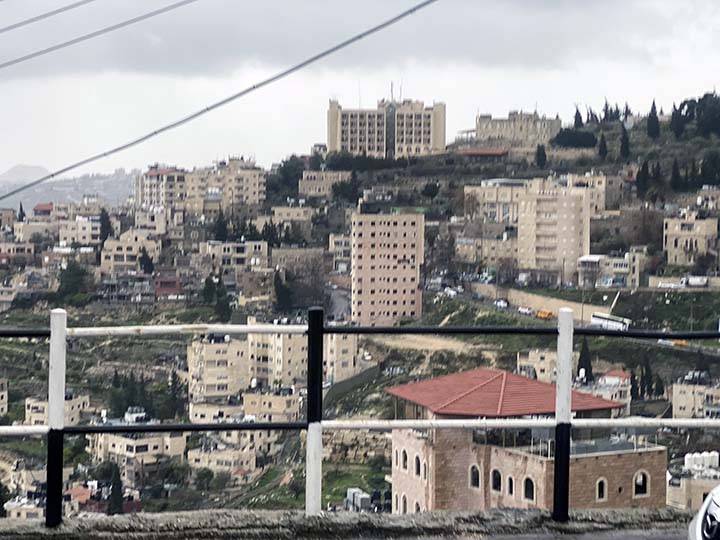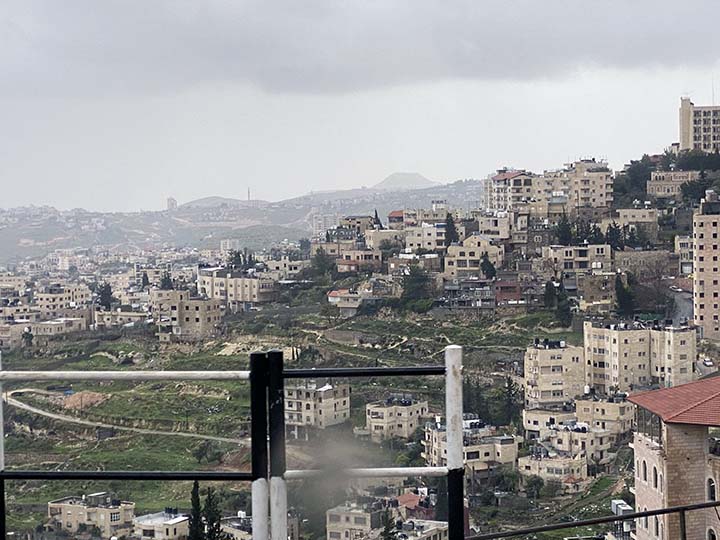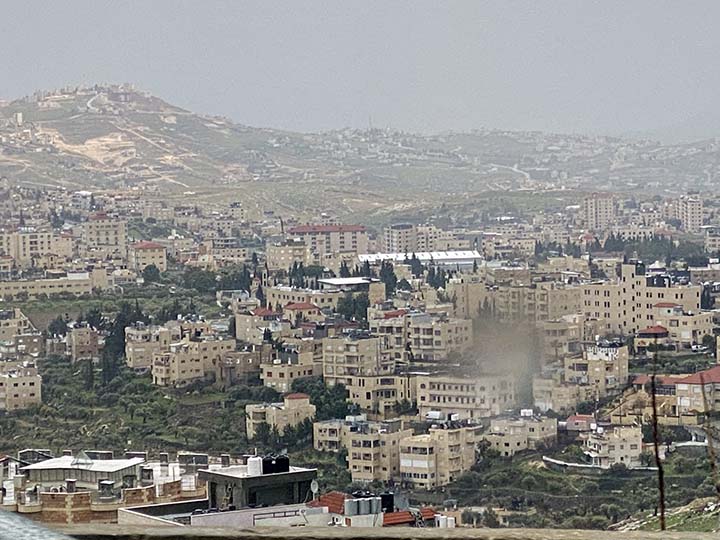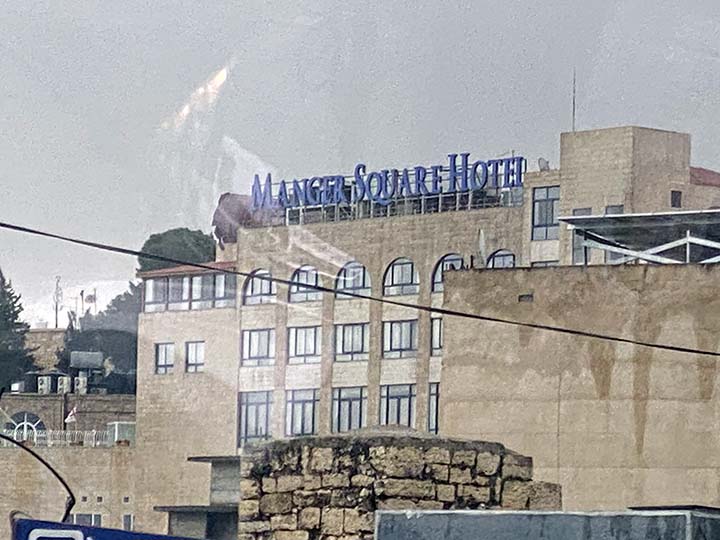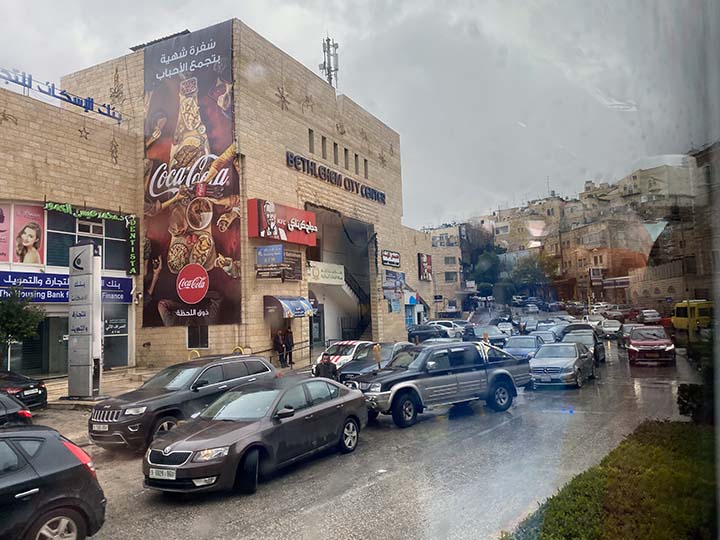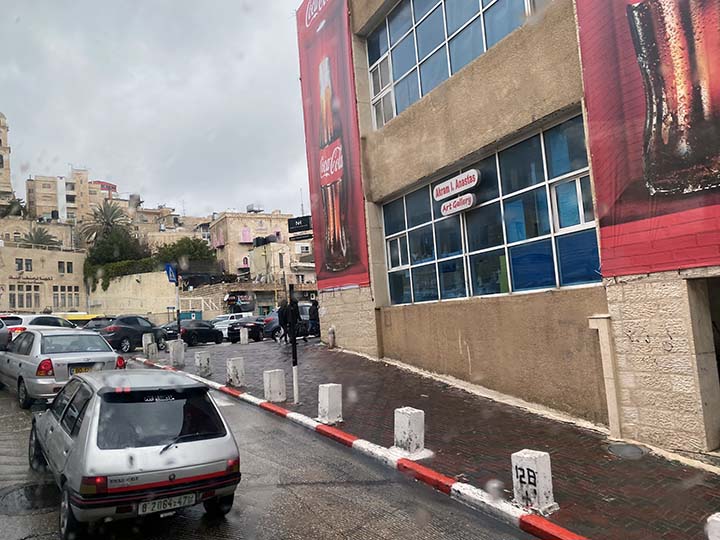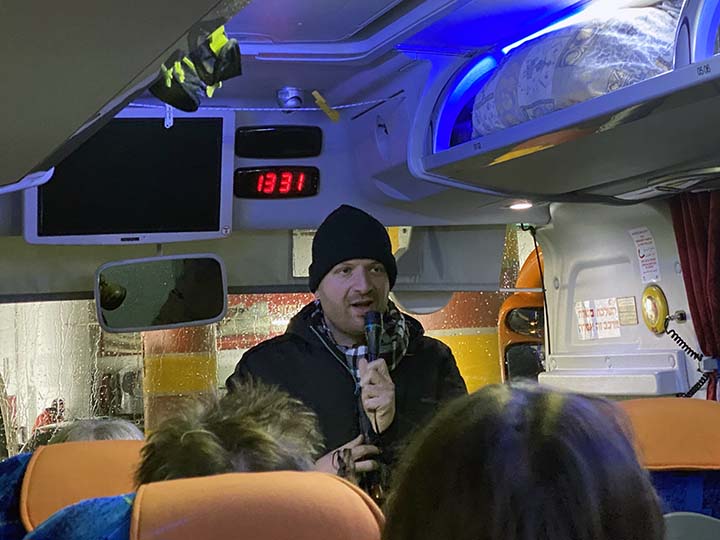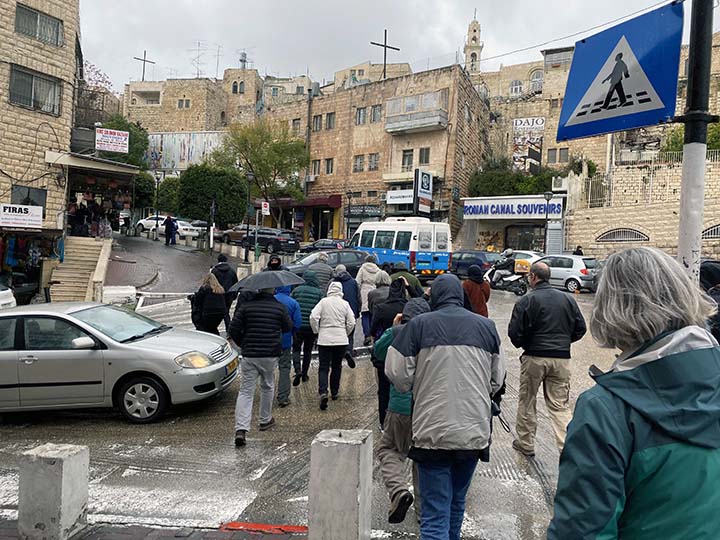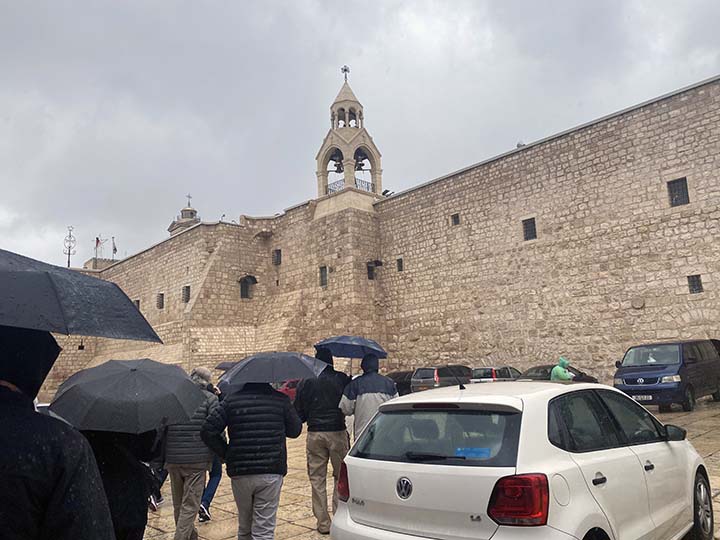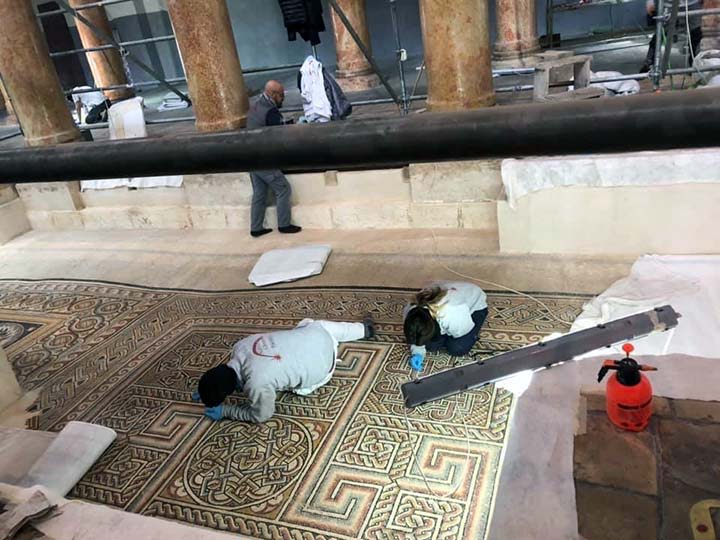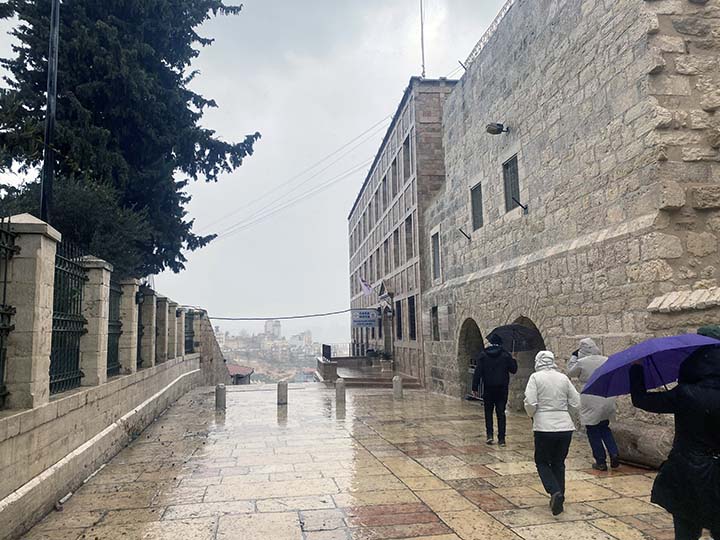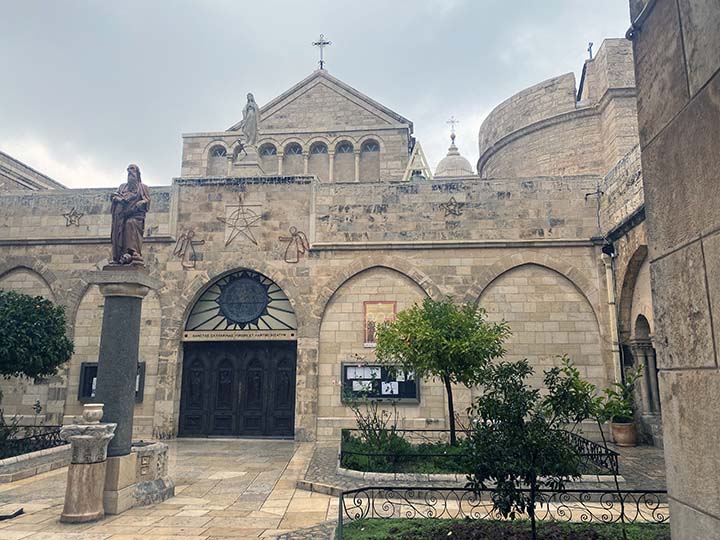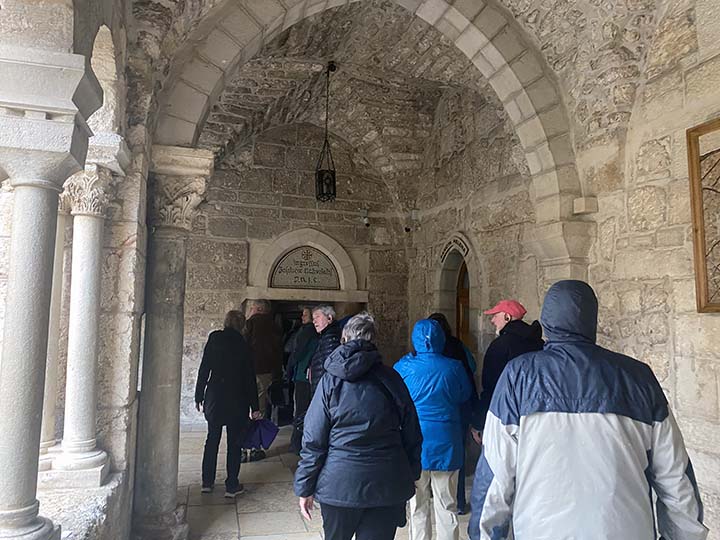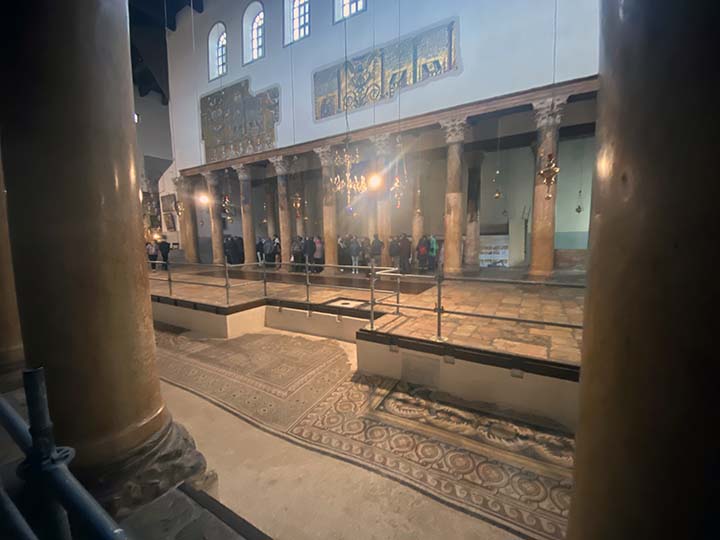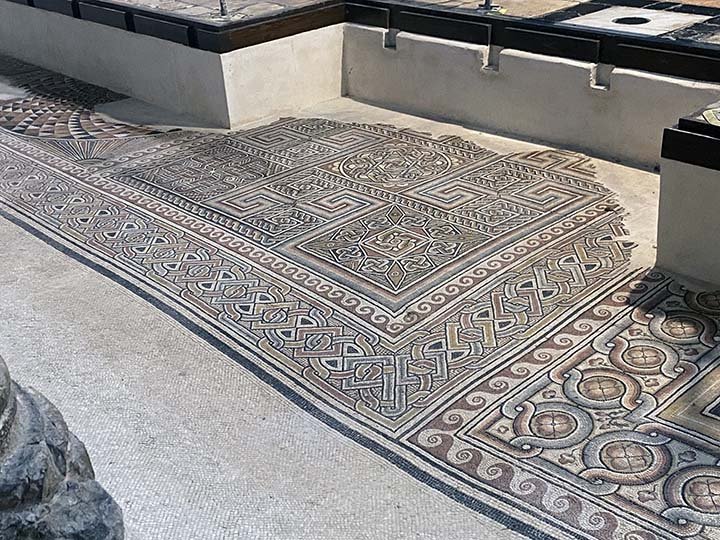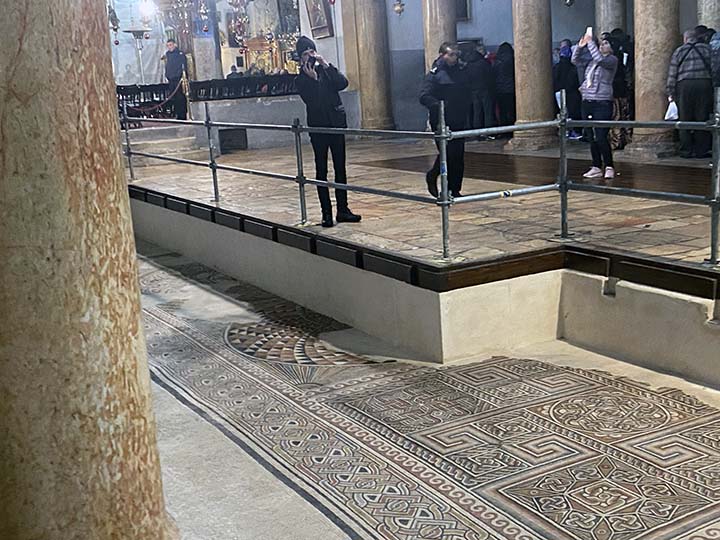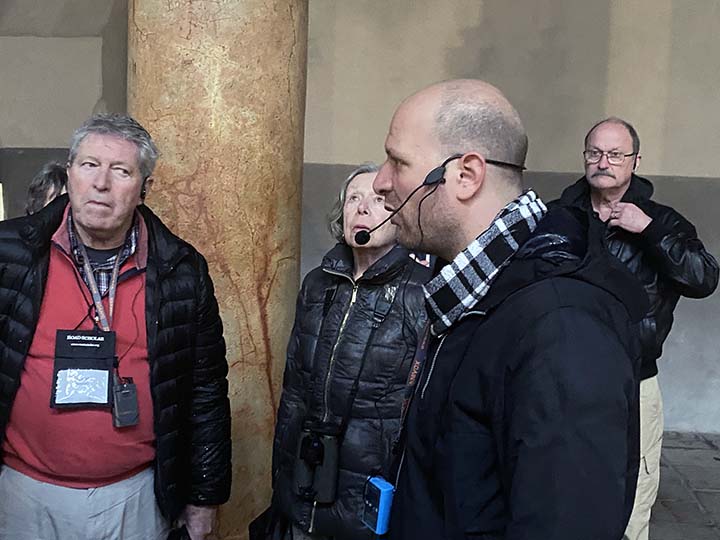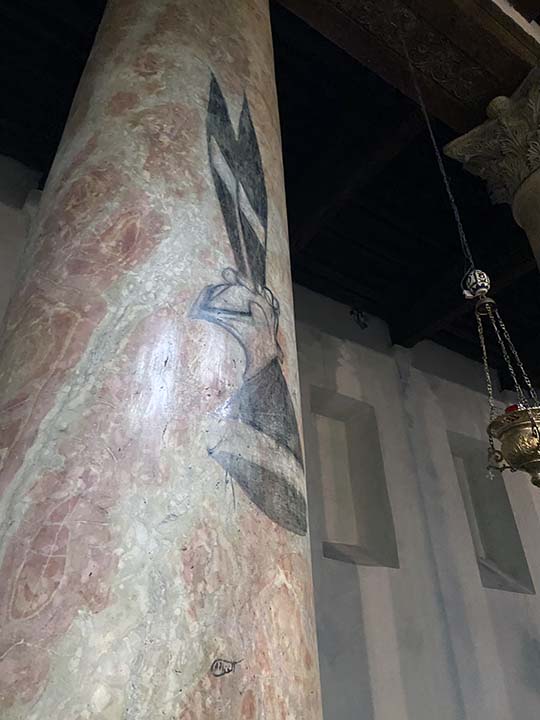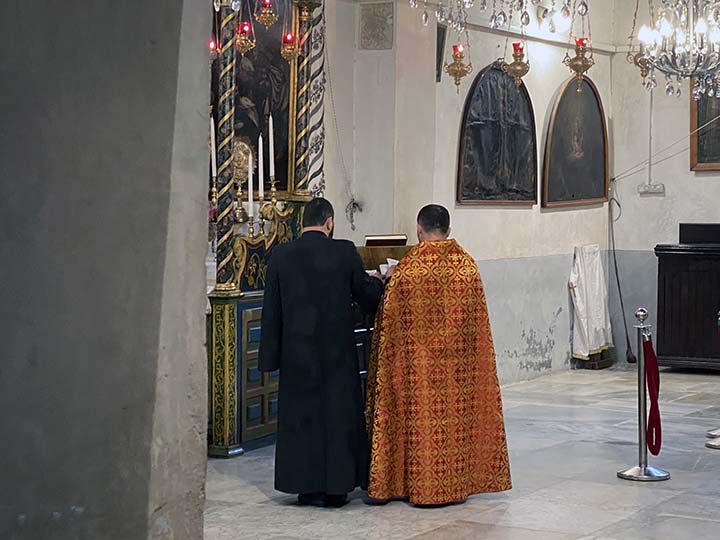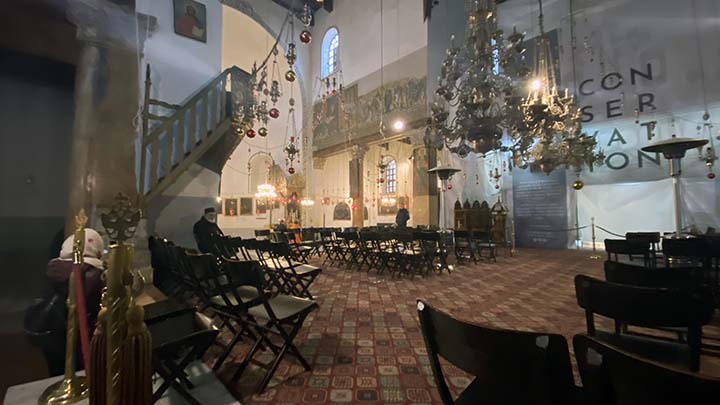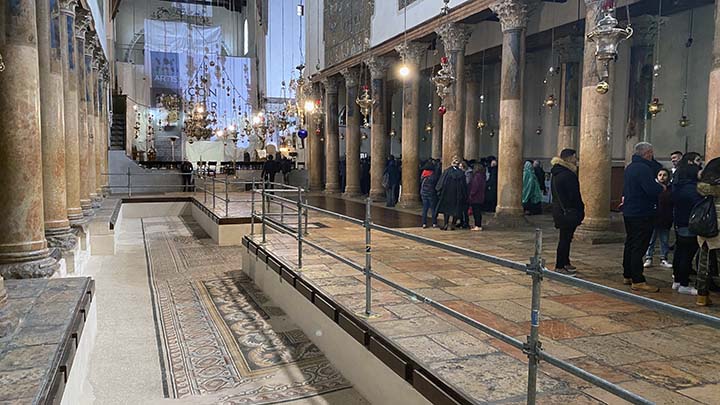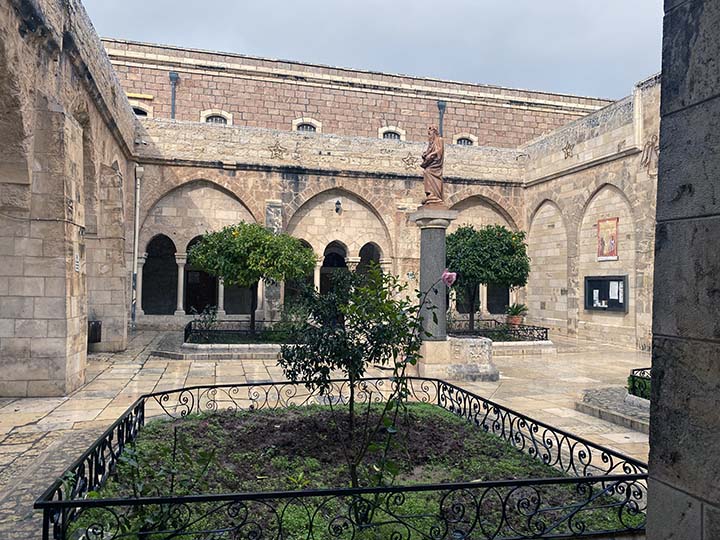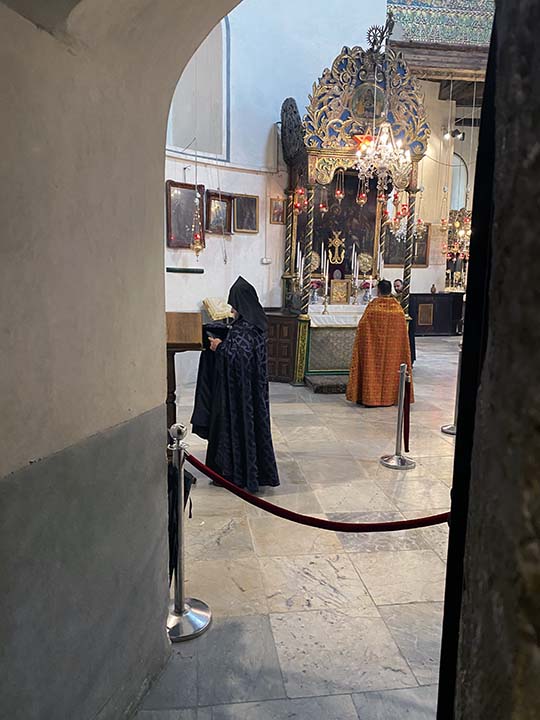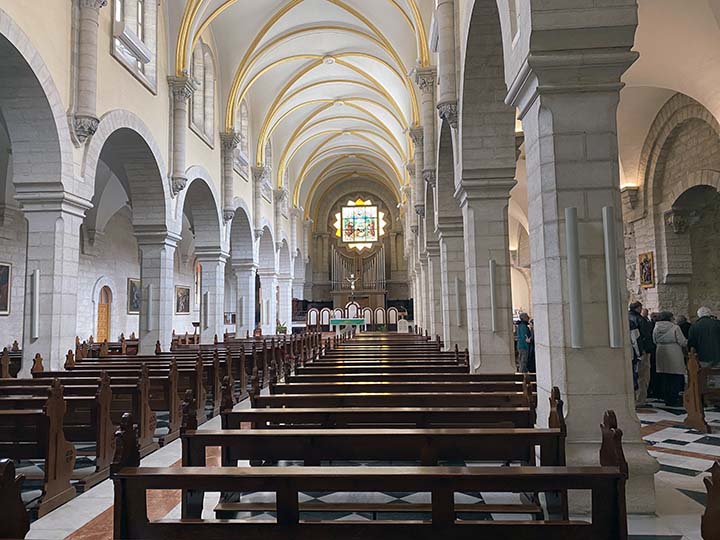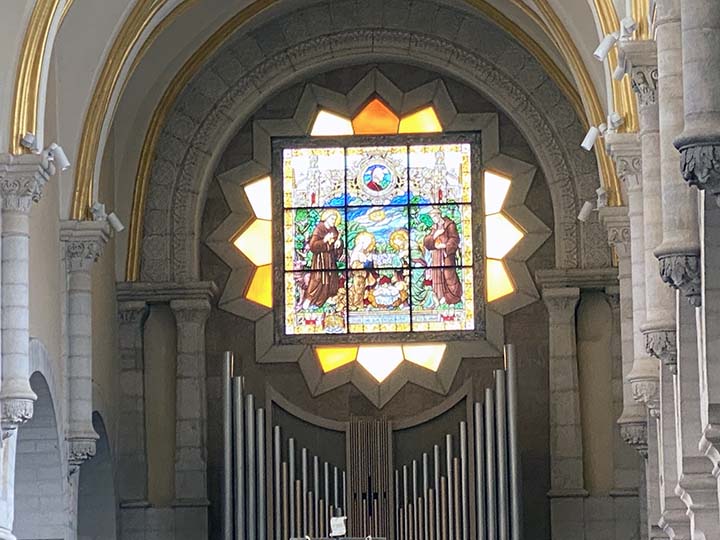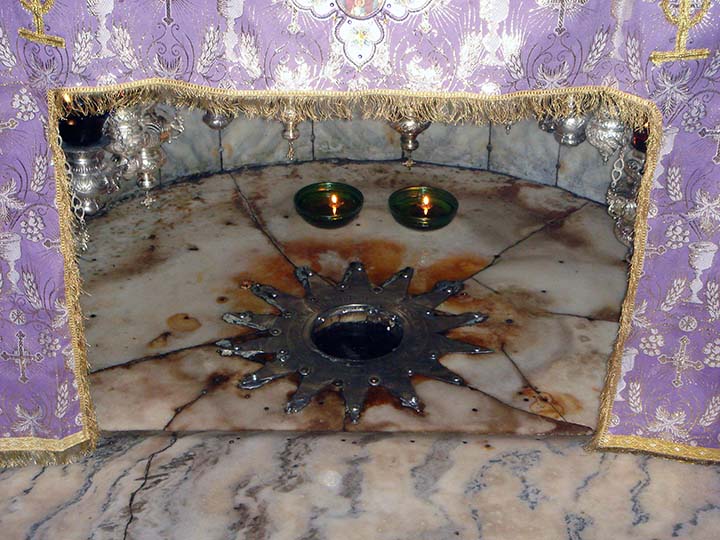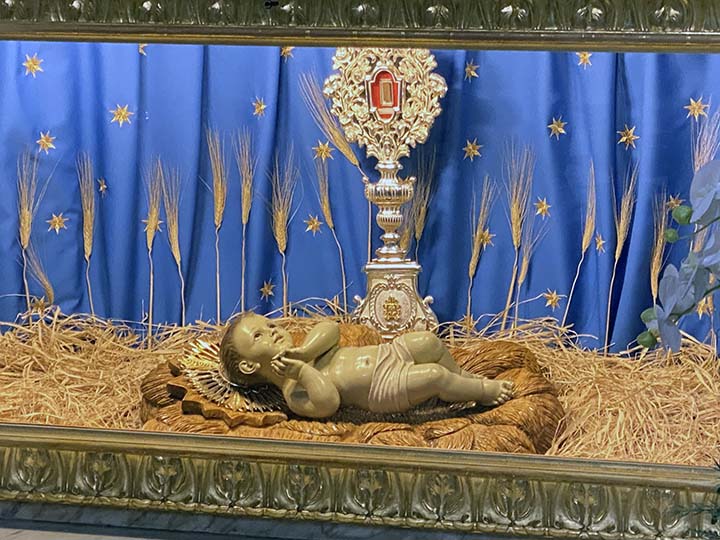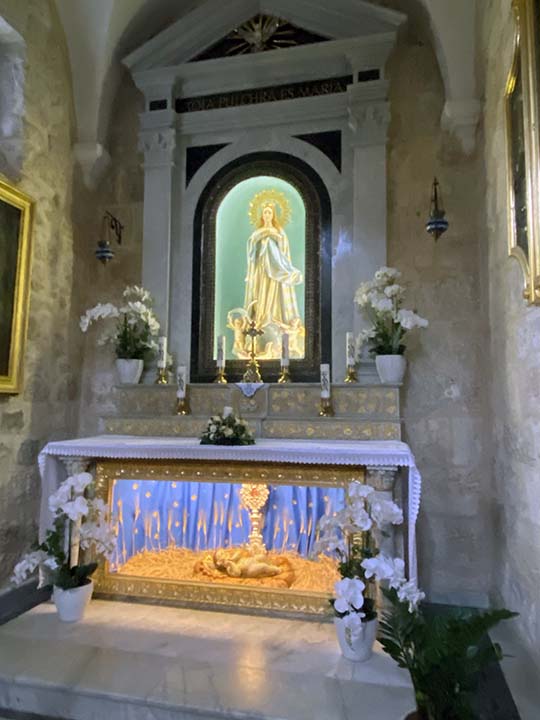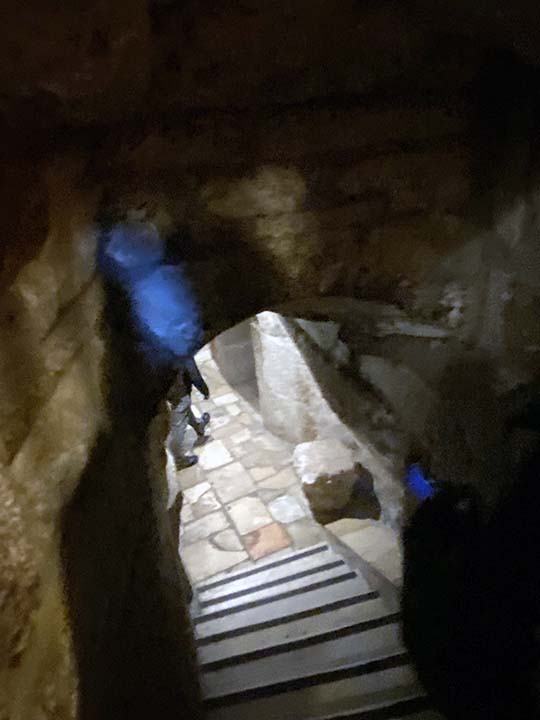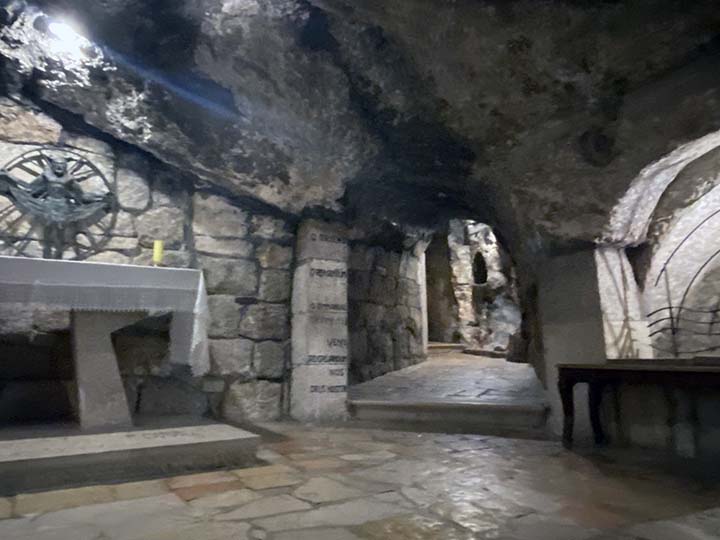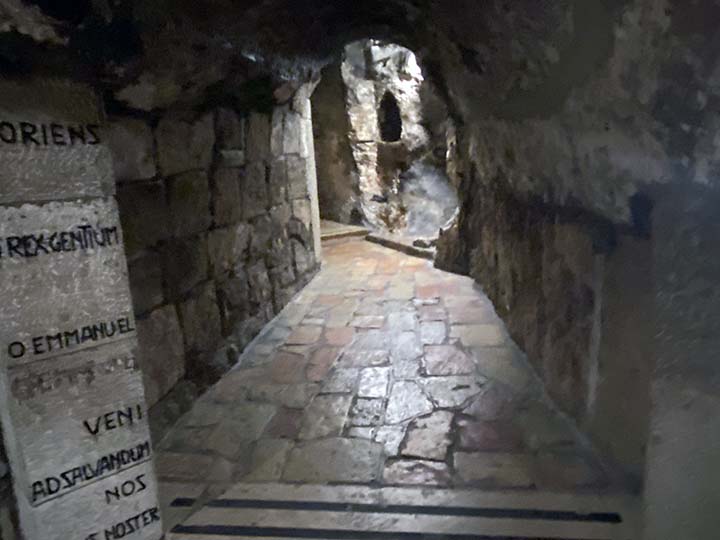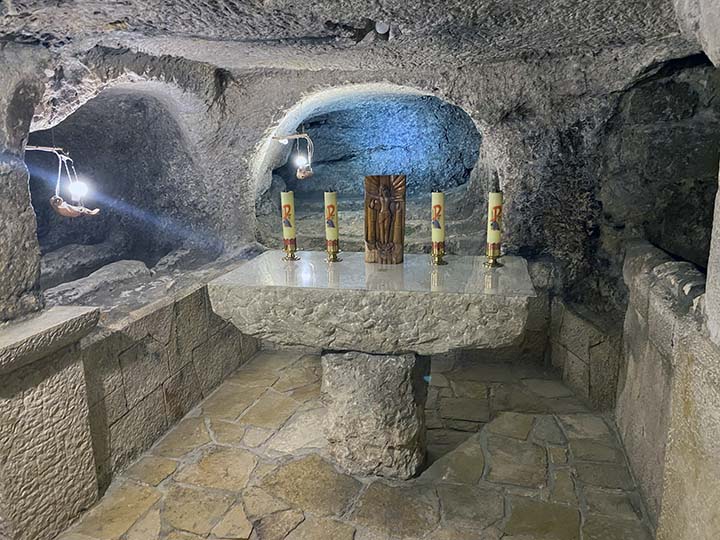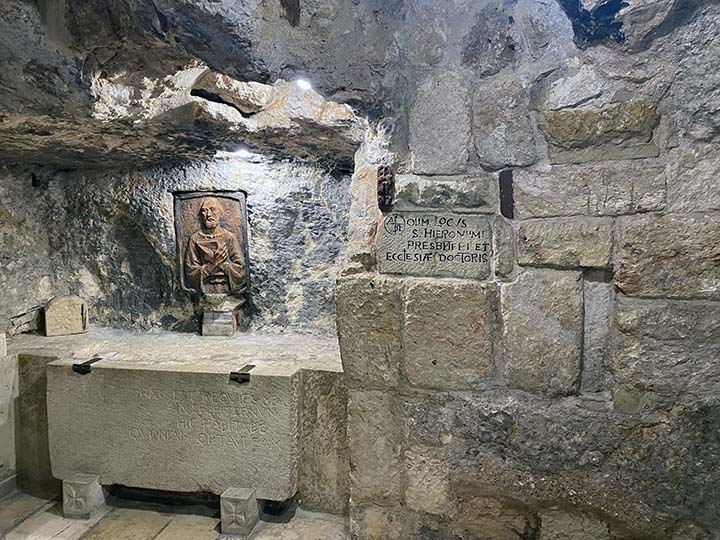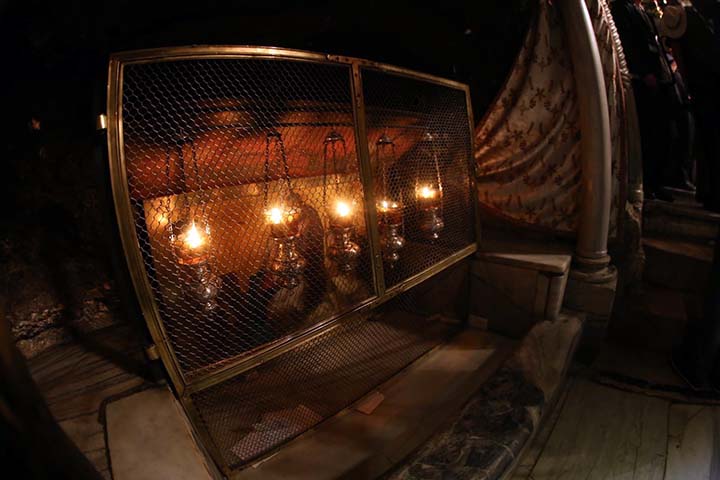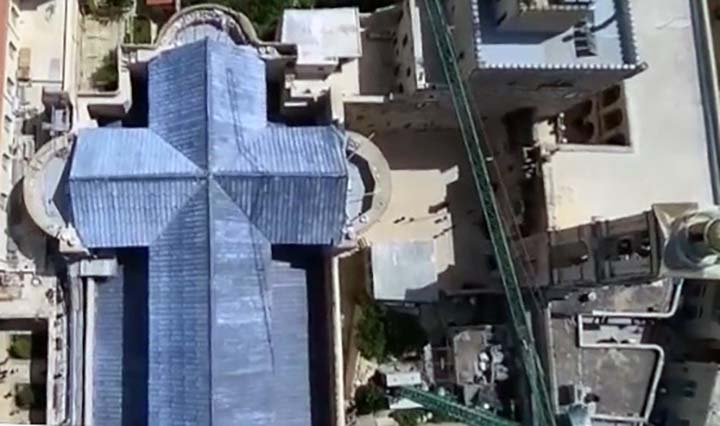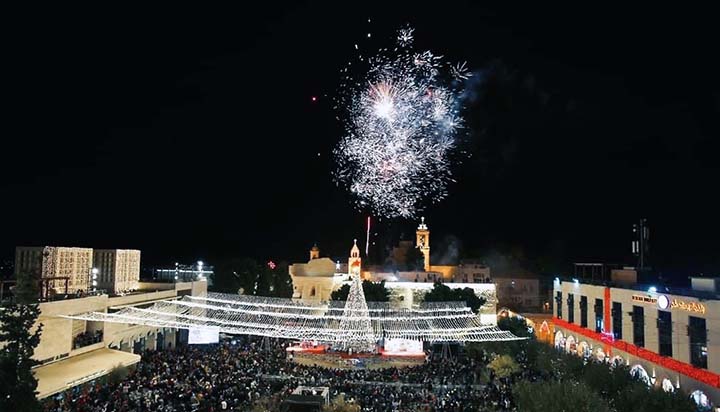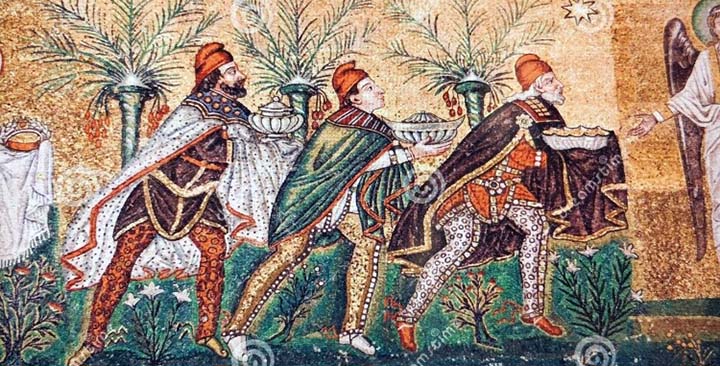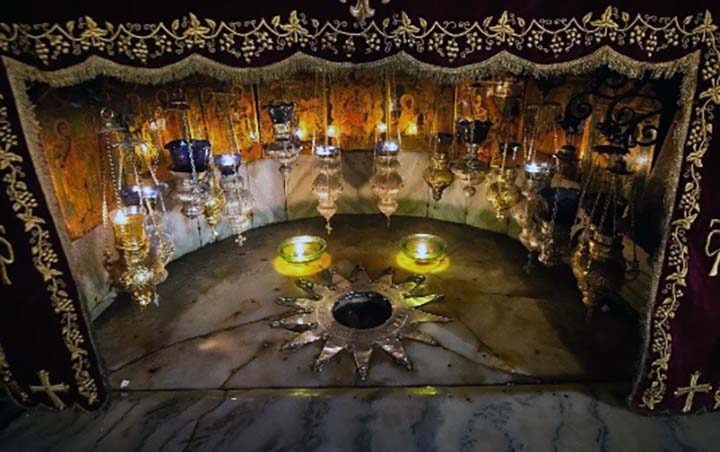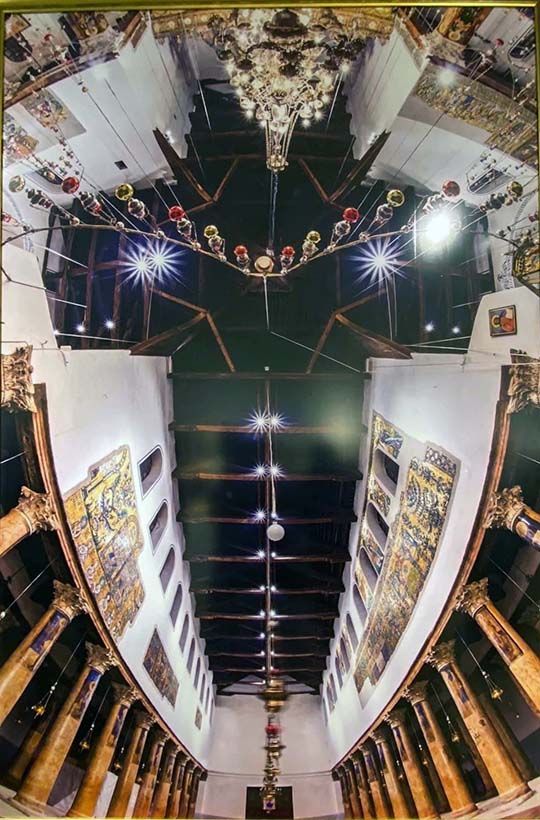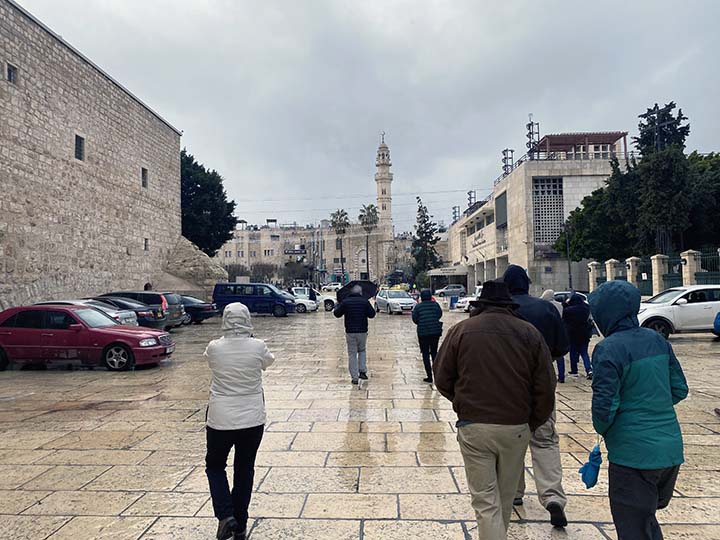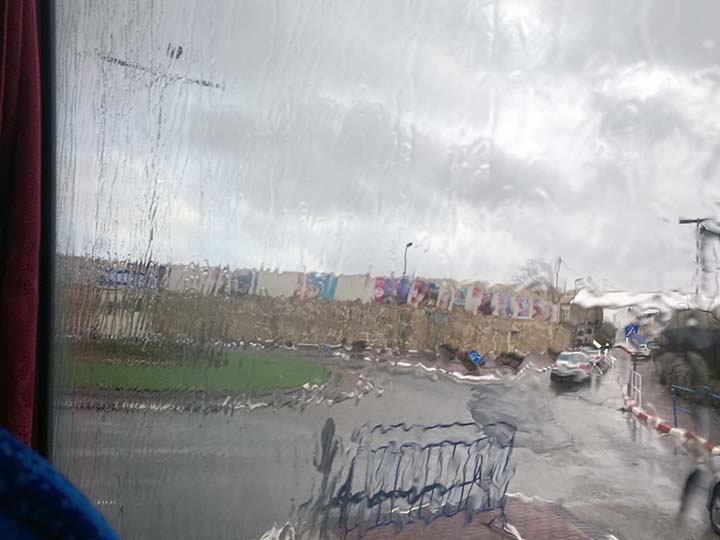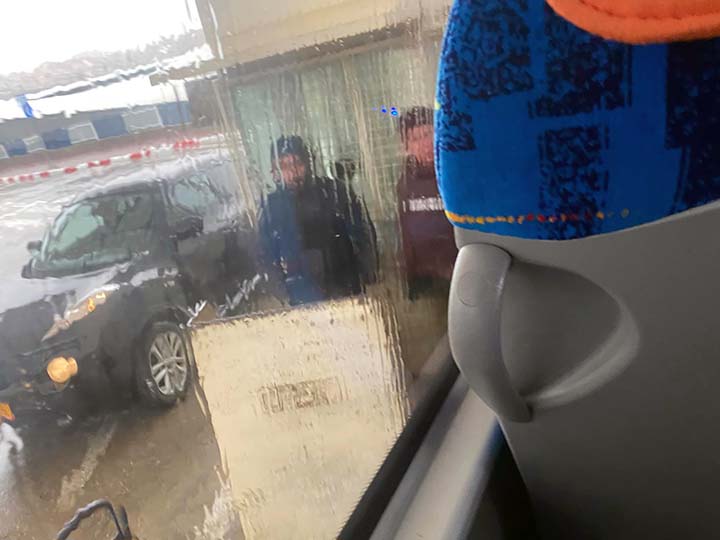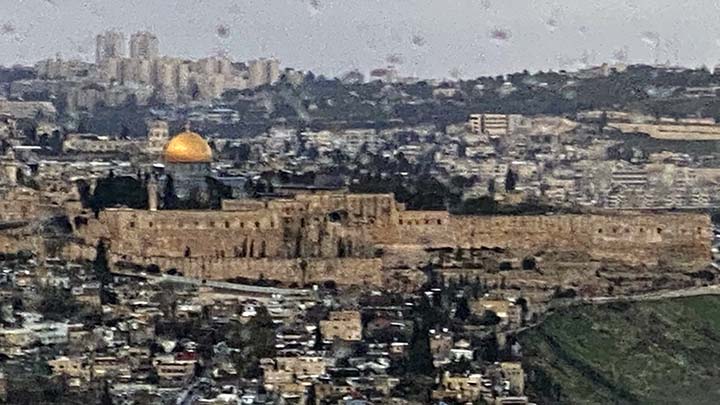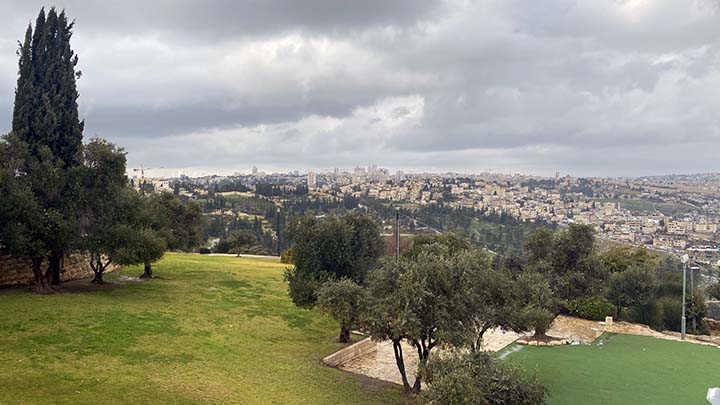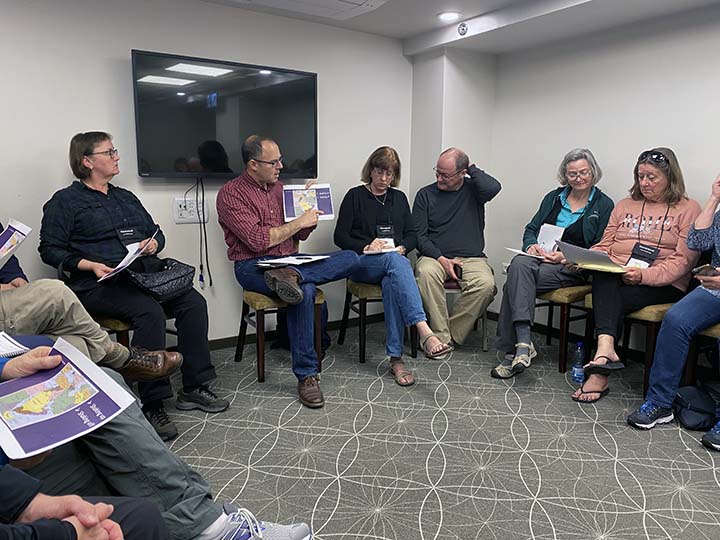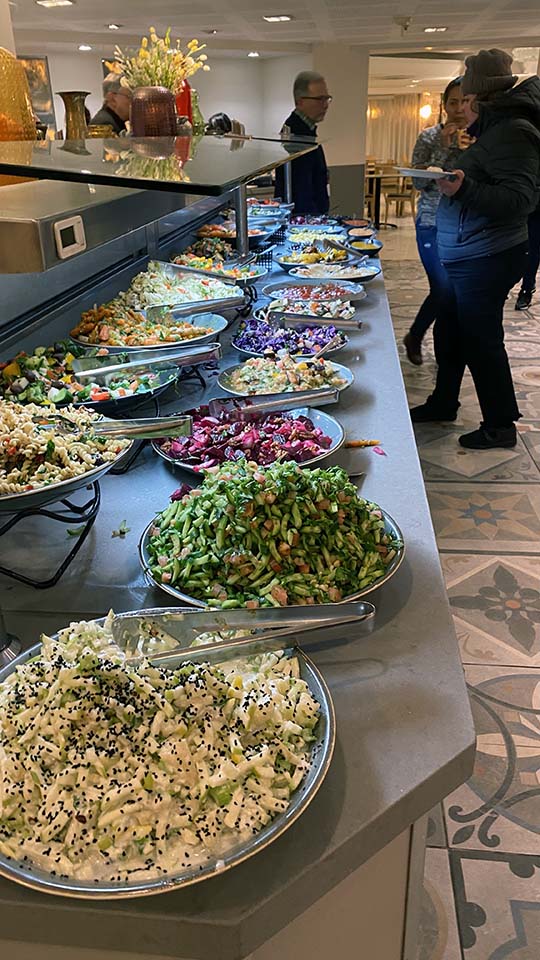|
In all my travels with Road Scholar, this has been truly the worst weather day. We got cold, we got wet, we even felt sleet smacking on our rain jacket hoods there for a little while. But were the intrepid Road Scholars deterred? No they were not
We started off with a full Road Scholar breakfast. If nothing else, we will be well fed on this trip. This was the morning I discovered halva. It's a fudge-like confection made with tahini (sesame seed paste), sugar, spices and nuts. In fact, the Arabic word halva translates to ďsweetness.Ē It has a semisweet, nutty flavor and crumbly, fluffy texture. And it's yummy.
Sure is wet out here this morning.
Even the guy with the halo is wet.
At least the bus would be dry today, and warm most of the time.
Itís the wall of the old city of Jerusalem. We are headed down a steep road into a ravine and will go back up the other side onto the Mount of Olives.
A distant view of the wall.
And here is the view of the old city from the Mount of Olives.
I'll bet somebody would be using this little lecture amphitheater if it weren't cold and miserable today.
See the Dome of the Rock? We won't be going there. Too bad.
The tourist is cold, heís wet, and still heís impressed.
This is where we are looking out. Everything is identified. I'd enjoy spotting all the sights if I weren't cold and miserable.
It's a cemetery. Shari Says it is good to be buried on the Mount of Olives because when the end times come all the dead will have to make their way to Jerusalem, and itís really not very far from here. It will all be about convenience.
See? Just a hop skip and jump across the ravine.
Shari is one of the very best Road Scholar guides I've ever known. Competent, knowledgeable and warm.
Warm comes in handy on a day like today.
That right there is an Eastern Orthodox church, I betcha.
Miserable weather hasn't stopped the tourists.
They're everywhere.
Let's go to the Old City. The Jerusalem we read about in the Bible.
We'll go inside the wall and see the old city.
Weíll use the Jaffa gate.
See? Told you.
And this is what the old city looks like when you donít have your waterproof hoodie pulled down so low you canít see anything.
Is it possible Pontius Pilate put Jesus on trial behind that wall? Lots of people think so.
Jesus saw that building. You can make up stuff about where the manger rested and where the True Cross Truly Stood, but you can't make up this stuff. This is real.
Oh boy! Trinkets!
Lots and lots of trinkets.
The Road Scholars have no time for trinkets.
We stopped for quite a while in this blessedly dry passageway and talked about the city. I think I will always remember how great the air smelled right here.
One of the merchants was burning frankincense. Mmm...Just take a sniff....
That right there is an entrance to the Mosque of Omar. After the Siege of Jerusalem in 637 by the Rashidun army under the command of Abu Ubaidah ibn al-Jarrah, Patriarch Sophronius refused to surrender except to the Caliph Omar (579-644) himself. Omar traveled to Jerusalem and accepted the surrender. He then visited the Church of the Resurrection (today better known as the Church of the Holy Sepulchre) where Sophronius invited him to pray inside the church, but Omar declined so as not to set a precedent and thereby endanger the church's status as a Christian site. Instead he prayed outside, on the steps east of the church. The first Mosque of Omar was later built at that site, as evidenced by a stone plate with a Kufic inscription found in 1897 in the area of the eastern or outer atrium of the Constantinian (4th-century) Church of the Resurrection, defining this area as a mosque. But this isnít that mosque. The current mosque is located at a different site than the one where Omar is believed to have prayed and where the earlier mosque was located, since it stands to the south of the church rather than to the east of it. This new position is likely due to the fact that the entrance to the Church of the Holy Sepulchre had by then moved from the east to the south of the church, as a result of repeated destructive events that affected the Holy Sepulchre during the 11th and 12th centuries. Got that?
The Road Scholars remain cold and wet and interested in all this.
Right after the Emperor Constantine told all the Romans that, like it or not, they had just become Christians, his mother, Helena, built a church to encompass the site of the death, burial and resurrection of Jesus. Itís called the Church of the Holy Sepulchre.
And today it is crowded. Shari Says she has never seen it this crowded.
So why so many people today? Everybody wants to get in out of the rain.
So says Shari.
What is everybody kissing?
Maybe the answer is provided in the wall decorations.
Jesusí disciples laid his body on a slab to prepare it for burial.
And now everybody wants to kiss this slab. I get it now. But I ain't kissin' no rock.
Still crowded.
Well, it's cold and wet out there!
These people are lined up to pay reverence to a spot on the floor.
It's over there.
No, not here.
It's over there by the tasteful decorations.
Under that altar where everybody's kneeling.
Right under that altar is the spot where Jesus' cross stood. Yes, that very spot. Wait, what? Youíre skeptical? Well just try to prove itís not the right spot. Go on, Iím waiting. Meanwhile people are lining up to crawl under the altar and kiss the spot. People sure do a lot of kissing in here.
That's the very place where the Cross stood. Or not. Actually, somebody commented that we are pretty confident this church was built on the site of the Biblical Golgotha so the actual spot had to be around here somewhere close by and in fact there's no evidence this ISN'T the actual spot, so sure...why not. Go ahead and kiss.
Let's look around where there aren't so many kissing tourists.
So Helena built this church over Golgotha and Jesusí tomb. And when there were just Christians and they hadnít divided themselves into lots of factions, everybody was happy with that. But now youíve got your Roman Catholics, and your Armenian Christians, and your Coptic Christians, and your Greek Orthodox, and I donít know what all, and everybody wants to run the place. So theyíve all agreed to a plan and everybody gets to be in charge for part of the day. Right now itís the Armenian Christians who are burning the incense and chanting the chants. That organ gets played only when the Roman Catholics take over.
Nice dome.
For a church so special to so many people throughout the world, they've kinda let the place run down. There used to be a person in that portrait but centuries of lamp smoke have rendered him almost invisible.
If you want, you can light a candle.
They say that is the earthís navel. Really, they say that. I'm not so sure.
It is sleeting now. We are cold and wet and miserable, though fascinated by what we have seen. We are headed back to the bus.
If only it were a pretty day. I could spend lots of time enjoying myself here.
But sleet is bouncing off my hoodie.
The crowds today are all going to church where it's warm(er) and dry(er).
The town is practically boarded up.
I could use a nice hot bagel about now.
Ah. But we have no time. Got to get back to our nice warm bus.
It's over there, somewhere. I think. Please, it's time to leave!
Letís go have lunch at a kibbutz. What's that, you ask?
It's a collective community in Israel, traditionally based on agriculture, in which members share wealth and material goods. Everybody lives together, everybody works together, all for one and one for all.
Here's what one looks like. We'll spend more time visiting a kibbutz later. Actually we did have a nice (warm) lunch here and afterward we were ready to press on.
We have gone through a checkpoint and passed through a wall and now we are in Palestinian country. We had to leave Shari behind because while they donít mind tourists coming in to spend money, they just really donít want Jewish tour guides to come with them. Now pay attention: see how that dark street shineth? Thatís right, we are in o little town of Bethlehem. Doesnít look so little, does it?
Of course there's an inn in Bethlehem. Wonder if it has any room?
It's really not a little town.
Very modern. Very crowded.
How still we see thee lie.
You'd think they'd have been able to find a room somewhere.
Like here.
I wonder how a donkey would maneuver through the traffic?
Thereís a bus terminal under that building with the Coca-Cola and KFC signs. We will stop here and pick up a Palestinian tour guide who will lead us to The Church of the Nativity.
The manger is just up there beyond the Coca Cola sign.
This is our Palestinian guide. His name was Yusef, or, in English, Joseph.
I wonder if there are any wise men in this group?
Well, they came equipped with umbrellas, so that's pretty smart I suppose.
Restoring a mosaic tiled floor.
Almost there.
The Church of the Nativity, or Basilica of the Nativity, is a basilica located in Bethlehem in the West Bank. The grotto it contains holds a prominent religious significance to Christians of various denominations as the birthplace of Jesus. The grotto is the oldest site continuously used as a place of worship in Christianity, and the basilica is the oldest major church in the Holy Land.
At least it isn't raining here.
The church was originally commissioned by Constantine the Great a short time after his mother Helena's visit to Jerusalem and Bethlehem in 325Ė326, on the site that was traditionally considered to be the birthplace of Jesus.
That original basilica was likely built between 330Ė333, being already mentioned in 333, and was dedicated on 31 May 339. It was destroyed by fire during the Samaritan revolts of the sixth century, possibly in 529, and a new basilica was built a number of years later by Byzantine Emperor Justinian (r. 527Ė565).
Not too long after Helena built this place, it burned down. Then, a few years later they rebuilt over it and the new structure has been here ever since. Itís been only a few years since there was an earthquake that revealed that mosaic tile floor which was part of the first building.
Joseph is going to show us the manger. Nothing is too good for Road Scholars.
That graffiti was painted on the wall by Crusaders. Really. Well, thatís what Joseph said anyway.
Current day graffiti artists could take some lessons here.
Priests engaged in priestly business.
Another sanctuary.
See how there are different levels of floor? The lower floor is left over from the first church on this site.
Looking around.
Courtyard.
Courtyard fruit. Oranges? Whatever, it's a pretty sight on a miserable day.
I think I saw that guy in a movie once. Vincent Price, I'm pretty sure.
This church has pews and everything.
Nice window.
This is the actual really and truly spot where the manger sat. Yes it is. OK, prove it's not. Anyway I didn't stand in the line to see this because, why? This pic from the internet is good enough for me.
I mean, the line to see the actual genuine absolutely definitely really and truly original manger was much too long for us to stand in. Well, OK, to see a re-creation that at least is actually in Bethlehem so itís got to be close to the real thing, right? In another, much less crowded room, this baby Jesus in a manger is admiring a little block of wood set on red velvet and surrounded by gold. The block is an actual genuine absolutely definitely really and truly chip off the original cross. Sure it is. Letís see you prove itís not. And even so, itís wood isnít it? So itís got to be close to the real thing, right?
You've got to understand. Even though I'm not buying into any of this "actual spot where it happened malarkey, I wouldn't have missed this experience for anything. I've always wondered what it would be like, and now I know.
We keep going down.
They say the Holy Family lived here.
Thatís where Joseph Mary and Jesus lived after the baby was born. Yes it is. Is so.
Diaper changing station?
Something wonderful happened there, I'm pretty sure.
Our guide Yusef gave us a web link to photos that have been taken here at the Church of the Nativity. But he didn't give us links to explanations of what the photos represent. I'd say these are lamps.
And this is a drone photo from high above the church. I'm sure you knew Catholic churches were built in the shape of crosses, but just in case you didn't...now you do.
They had fireworks here on Jesus' 2,000th birthday.
These three kings of orient are.
There's that birthplace again.
And that is the ceiling. Sure am glad I got these extra pictures.
Back to the bus.
This is a shopping area above the bus parking garage.
Now we're stopped at the Palestinian border with Israel.
These smiling happy friendly border guards just waved us through instead of asking to see the passports we were all carrying because weíd been told we would never get back into Israel without them. We mustíve waited 30 to 40 minutes in traffic to get through this border check and they didnít even want to see our passports. Kinda disappointing.
The rains had let up momentarily, so Shari took us to another overlook. That right there folks is the Jerusalem youíve heard so much about.
The blue sky lasted maybe 90 seconds.
See?
It may not be raining any longer but itís still cold and windy and Iím going back to the bus.
And after two hours rest we received a lecture from an expert on Israel from an Israeli perspective. His name was Daniel Sherman and he was very interesting. I hate that I still have jet lag and I nodded off more than once. This guy was good. Tomorrow night we will hear essentially the same story but from a Palestinian perspective.
Now letís eat!
As with every road scholar program, so far, the food is outstanding.
|

